The Palace of Versailles was built by King Louis XIII in 1623 as a hunting lodge but transformed by his son, King Louis XIV, into an extravagant palace reflecting absolute monarchy. The palace features classical French Baroque style, including the Hall of Mirrors with its original practical use to reflect sunlight and candlelight.
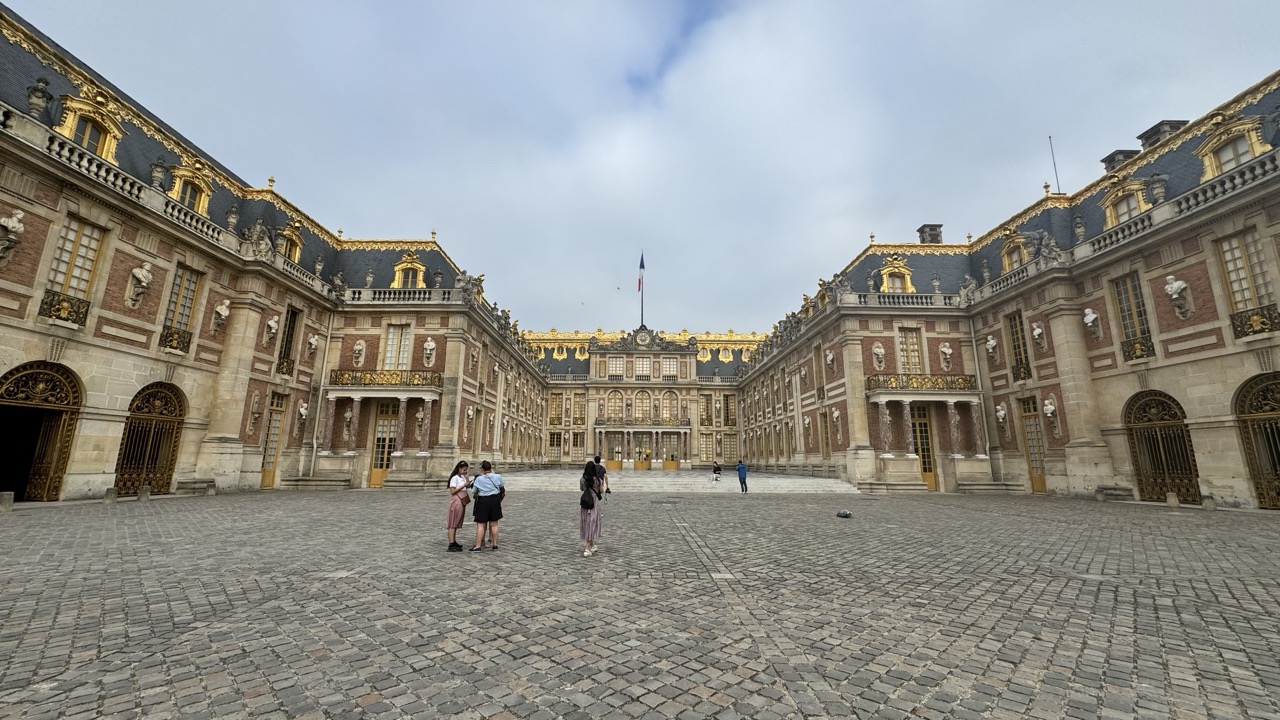
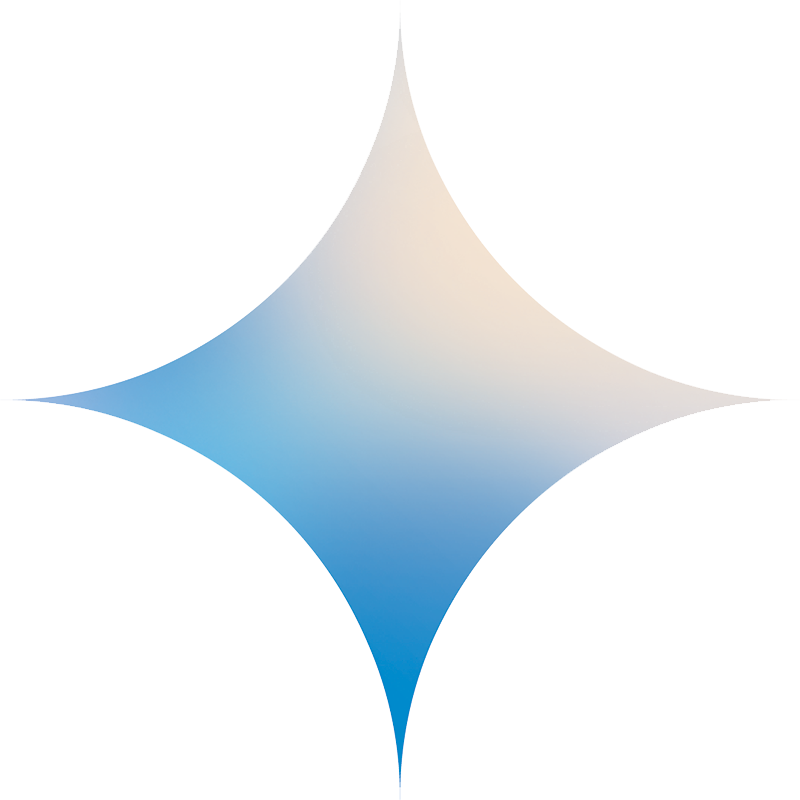
1. Overall Rating (0–10) — 7.0
This photograph captures the grandeur of Versailles’ courtyard with a sense of scale and historical weight, where the architecture’s ornate details speak to a bygone era of opulence. The overcast sky tempers the gold accents, lending a somber, contemplative mood that contrasts with the usual spectacle of the palace. While the image effectively conveys the space’s vastness, the human figures, though small, add narrative context—yet the composition’s symmetry and flat lighting slightly diminish its emotional punch.
2. Composition (0–10) — 7.5
The symmetrical framing emphasizes the palace’s architectural harmony, with the central building drawing the eye. The cobblestone courtyard leads the viewer toward the focal point, while the scattered tourists provide scale and a subtle sense of life.
3. Lighting (0–10) — 6.0
The diffused, overcast light softens shadows and flattens the scene, minimizing the dramatic interplay of light and shadow. While this ensures even exposure across the facade, it slightly dulls the richness of the gold details.
4. Color & Tone (0–10) — 6.5
The palette is dominated by muted grays and earthy tones, with golden accents providing visual warmth. The overall tone is subdued, reflective of the cloudy sky, which tempers the potential vibrancy of the scene.
5. Creativity (0–10) — 6.0
The image is a strong architectural document, but it leans toward the conventional rather than the evocative. The symmetry is effective, but the lack of dynamic lighting or unusual perspective limits its originality.
6. Technical Quality (0–10) — 8.0
The image is sharp and clear, with well-defined textures in the stonework and cobblestones. The wide-angle perspective captures the full scope of the courtyard without significant distortion.
7. Emotional Impact (0–10) — 6.5
The photograph evokes a quiet reverence for history and grandeur, but the lack of dramatic lighting and human engagement keeps the emotional connection at a distance. It feels more like a visit than a revelation.
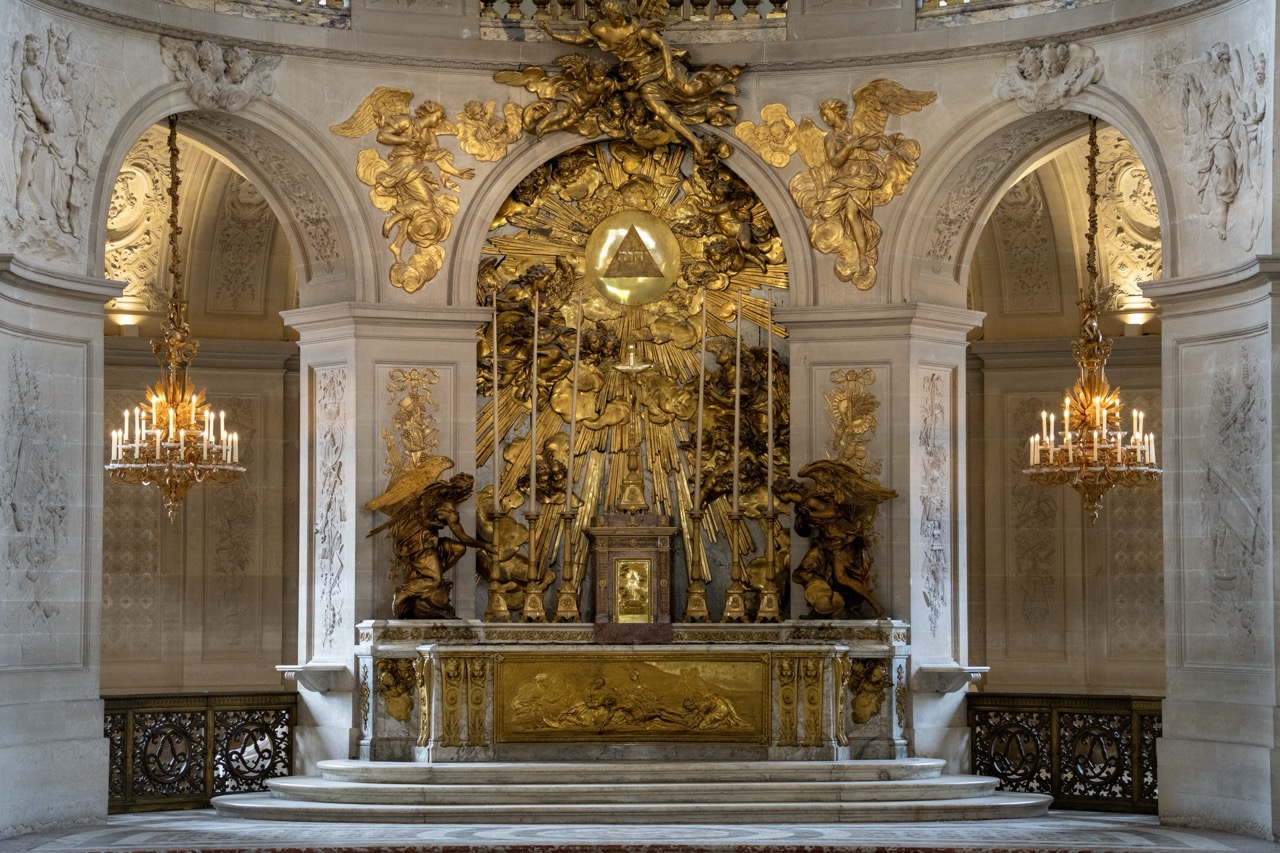

1. Overall Rating (0–10) — 8.5
This photograph captures the opulent grandeur of a Baroque chapel, where light and gold converge to evoke a sense of divine transcendence. The intricate gilded altarpiece, flanked by angelic figures and illuminated by candlelit chandeliers, commands reverence and awe. While the scene is visually overwhelming, the image's strength lies in its ability to convey both the spiritual weight and the artistic mastery of the space—though the sheer density of detail risks visual fatigue upon prolonged viewing.
2. Composition (0–10) — 9.0
The image is masterfully composed with strong symmetry, centered on the altar and framed by the arches, creating a sense of balance and order. The placement of the chandeliers on either side reinforces this equilibrium, while the steps leading up to the altar guide the viewer’s eye toward the focal point, enhancing the sense of depth and hierarchy.
3. Lighting (0–10) — 8.5
The warm, diffused lighting from the chandeliers casts a soft glow across the golden embellishments, accentuating their three-dimensional texture and reflective quality. The interplay of light and shadow enhances the drama of the scene, while the ambient illumination ensures that the architectural details remain clearly visible without harsh overexposure.
4. Color & Tone (0–10) — 9.0
The dominant palette of gold and cream creates a luminous, harmonious atmosphere, while the subtle contrast with the cool gray stone adds depth and visual interest. The rich tonal range—from the deep shadows in the recessed arches to the bright highlights on the gilded surfaces—lends the image a regal and timeless quality.
5. Creativity (0–10) — 8.0
The photograph captures the chapel not merely as a subject, but as a narrative of faith and power. The choice to frame the image with such symmetry and reverence elevates the scene beyond mere documentation into an artistic interpretation of sacred space. While the subject itself is traditionally grand, the photographer’s approach imbues it with a contemplative, almost cinematic quality.
6. Technical Quality (0–10) — 9.0
The image is sharp and well-defined, with excellent control over focus and detail, particularly in the intricate carvings and gilded elements. The exposure is balanced, preserving highlights and shadows without clipping, and the camera’s resolution captures the textures of marble, metal, and candlelight with clarity.
7. Emotional Impact (0–10) — 8.5
The photograph evokes a profound sense of awe and reverence, inviting the viewer to pause and reflect on the craftsmanship and devotion embodied in the space. The combination of light, gold, and symmetry creates an atmosphere of spiritual elevation, making the viewer feel both small and connected to something greater.
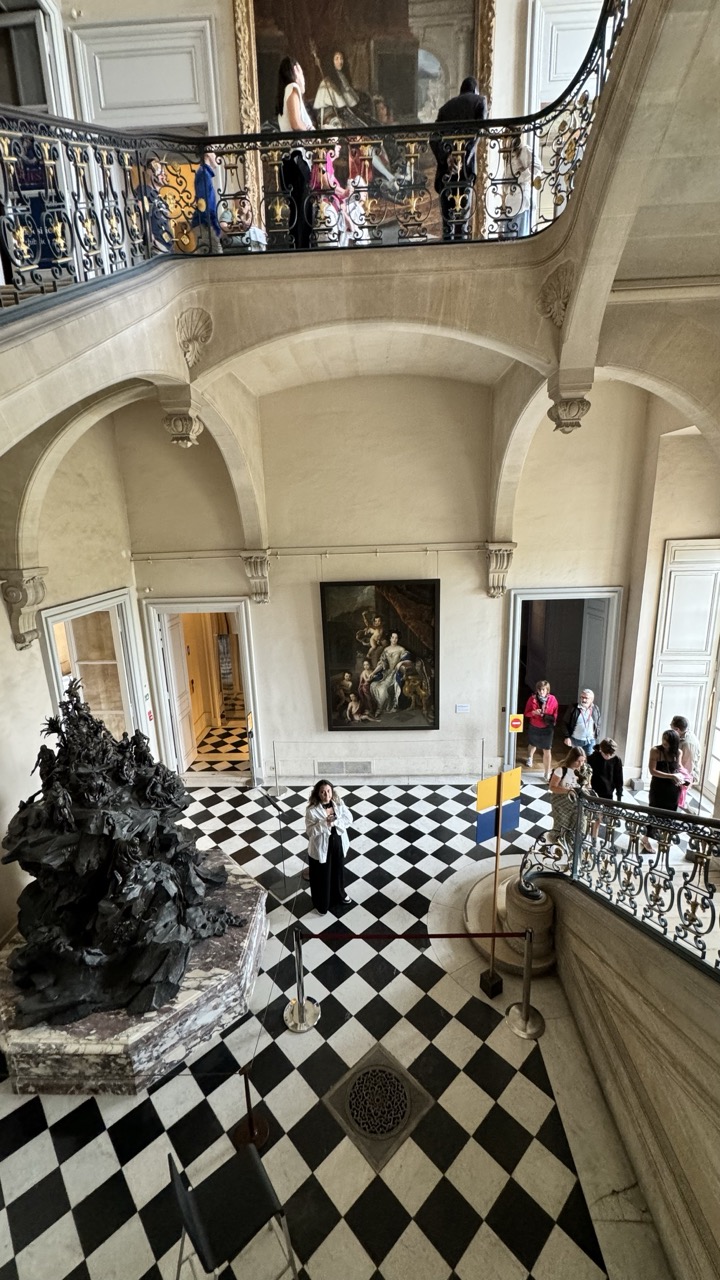

1. Overall Rating (0–10) — 7.0
This photograph captures the grandeur and layered history of a European museum interior, where classical architecture meets contemporary art. The contrast between the ornate, symmetrical hall and the raw, chaotic sculpture creates a compelling visual dialogue. While the image effectively conveys the scale and atmosphere of the space, the composition's complexity risks overwhelming the viewer, and the lighting, though adequate, lacks the dramatic depth to fully elevate the scene.
2. Composition (0–10) — 6.5
The high-angle perspective offers a comprehensive view of the space, emphasizing the symmetry of the arches and the checkerboard floor. However, the inclusion of too many elements—visitors, railings, multiple doorways—creates a slightly cluttered feel, with the large sculpture on the left competing for attention with the central painting and the upper balcony.
3. Lighting (0–10) — 6.0
Natural light filters in from the upper levels, illuminating the hall evenly but without strong directional emphasis. The light is soft and diffused, preserving detail but diminishing the play of shadows that could enhance the room’s depth and texture.
4. Color & Tone (0–10) — 6.5
The palette is restrained, dominated by the black-and-white checkered floor and the beige stone, which gives the image a formal, almost monochromatic tone. The dark sculpture and the rich hues of the painting provide focal points, but the overall color scheme feels subdued, limiting emotional contrast.
5. Creativity (0–10) — 7.0
The juxtaposition of classical architecture with a modern sculpture introduces a thought-provoking narrative about time, tradition, and artistic evolution. The framing suggests a deliberate choice to highlight this tension, making the image more than a simple architectural snapshot.
6. Technical Quality (0–10) — 7.5
The image is sharp and well-focused, with clear details in the sculpture, the painting, and the architectural elements. The exposure is balanced, and there is no noticeable noise, indicating strong technical execution.
7. Emotional Impact (0–10) — 6.0
The photograph evokes a sense of quiet contemplation and cultural richness, but the emotional resonance is tempered by the busy composition and lack of dramatic lighting. It invites the viewer to explore, but doesn’t pull them into a deeper emotional experience.
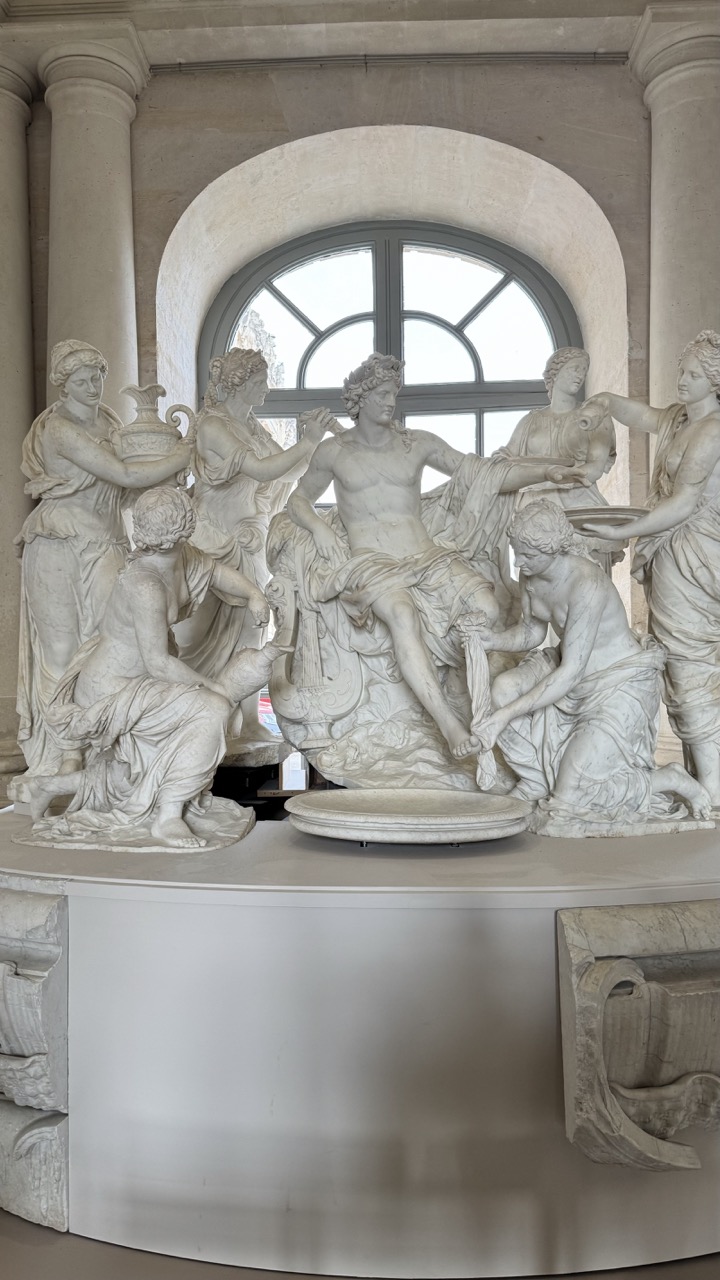

1. Overall Rating (0–10) — 7.5
This photograph captures the grandeur of a classical marble sculpture with a sense of restrained elegance, allowing the intricate details and mythological narrative to take center stage. The soft, diffused light enhances the sculpture’s form and texture, while the architectural setting provides a dignified backdrop. Though the image is technically sound, it lacks a dynamic perspective, which slightly diminishes its visual impact.
2. Composition (0–10) — 7.0
The sculpture is well-centered within the frame, with the arched window creating a natural vignette that draws the eye. The foreground pedestal and surrounding columns offer structural balance, though the composition feels slightly static due to the symmetrical arrangement.
3. Lighting (0–10) — 8.0
Natural light filters through the arched window, casting soft, directional illumination that highlights the contours and depth of the marble. The lighting is even and flattering, enhancing the three-dimensionality of the figures without creating harsh shadows.
4. Color & Tone (0–10) — 8.0
The monochromatic palette of creamy white marble is unified and serene, with subtle tonal variations that emphasize texture and form. The cool, neutral tones contribute to a sense of timelessness and classical refinement.
5. Creativity (0–10) — 7.0
The image successfully communicates the artistry and narrative of the sculpture, but its approach is more documentary than interpretive. A more adventurous angle or cropping could have elevated its artistic voice.
6. Technical Quality (0–10) — 8.5
The photograph is sharp and detailed, with excellent focus on the sculptural forms. The exposure is well-balanced, and the image is free of noise or distortion, showcasing the fine craftsmanship of the piece.
7. Emotional Impact (0–10) — 7.5
There is a quiet reverence in the image, evoking a sense of awe for the enduring beauty of classical art. The stillness of the scene invites contemplation, allowing the viewer to connect with the mythic story behind the figures.
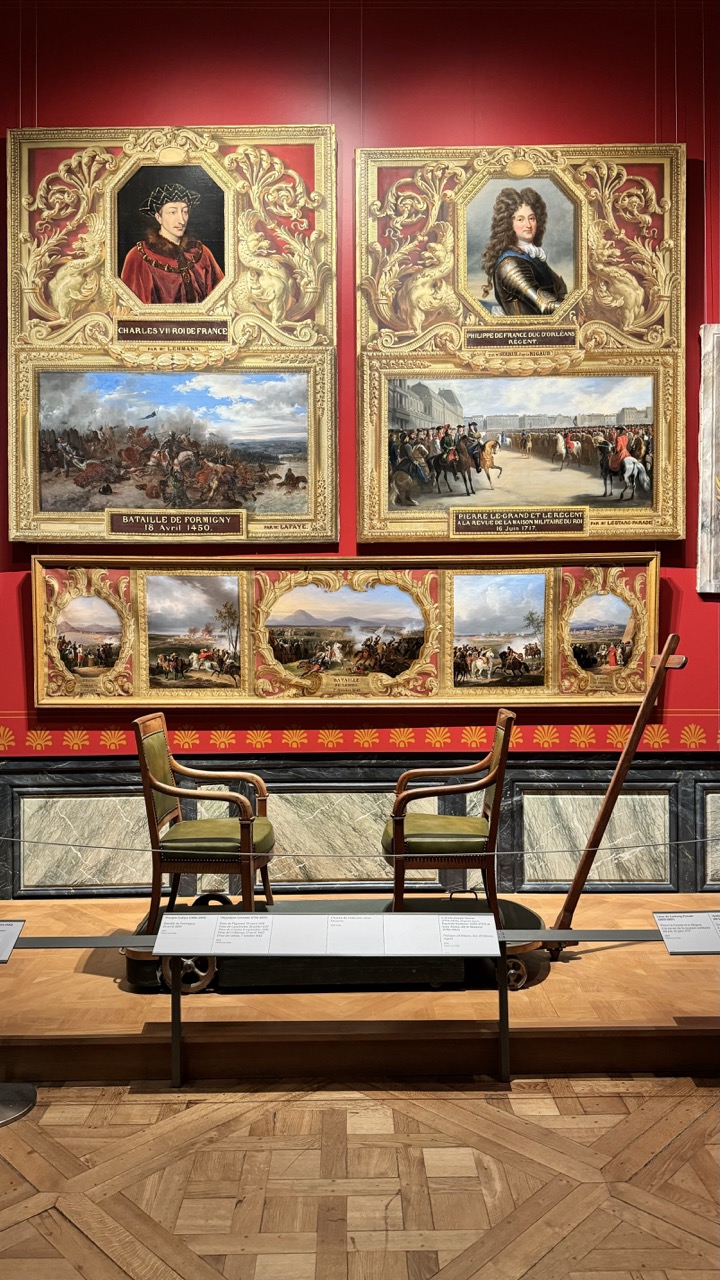

1. Overall Rating (0–10) — 7.5
This photograph captures the grandeur of a museum gallery dedicated to French military history, where opulent paintings and period furniture converge to evoke a sense of imperial legacy. The rich red walls and gilded frames create a dramatic backdrop, while the carefully arranged display invites contemplation of national identity and power. Though the image is slightly overexposed in the lower half, the composition effectively communicates the weight and scale of the historical narrative.
2. Composition (0–10) — 8.0
The symmetrical arrangement of the paintings and the balanced placement of the two armchairs create a strong sense of order and visual harmony. The lower horizontal band of paintings anchors the frame, while the vertical alignment of the larger portraits draws the eye upward, guiding the viewer through the narrative.
3. Lighting (0–10) — 7.0
The lighting is bright and even, illuminating the paintings clearly and highlighting the intricate details of the gold frames. However, the lower portion of the image appears slightly washed out, likely due to direct overhead lighting on the polished wooden floor, which detracts from the overall tonal balance.
4. Color & Tone (0–10) — 8.0
The deep red walls provide a bold, regal backdrop that enhances the golden tones of the frames and the earthy hues of the paintings. The contrast between the warm reds and the natural wood of the parquet floor adds depth and richness, creating a visually cohesive and historically resonant palette.
5. Creativity (0–10) — 7.0
The photograph successfully captures the theatricality of the museum display, emphasizing the curated nature of historical presentation. The inclusion of the armchairs and the cannon-like object adds narrative intrigue, suggesting a story beyond the paintings—though the approach is more documentary than conceptual.
6. Technical Quality (0–10) — 8.0
The image is sharp and detailed, particularly in the upper half where the paintings are clearly visible. Focus is consistent across the frame, and the exposure is generally well-managed, despite the minor overexposure in the lower section.
7. Emotional Impact (0–10) — 8.0
The scene evokes a sense of reverence and awe, inviting the viewer to reflect on the power and permanence of historical memory. The grandeur of the space and the solemnity of the portraits create a contemplative atmosphere, suggesting both pride and the weight of the past.
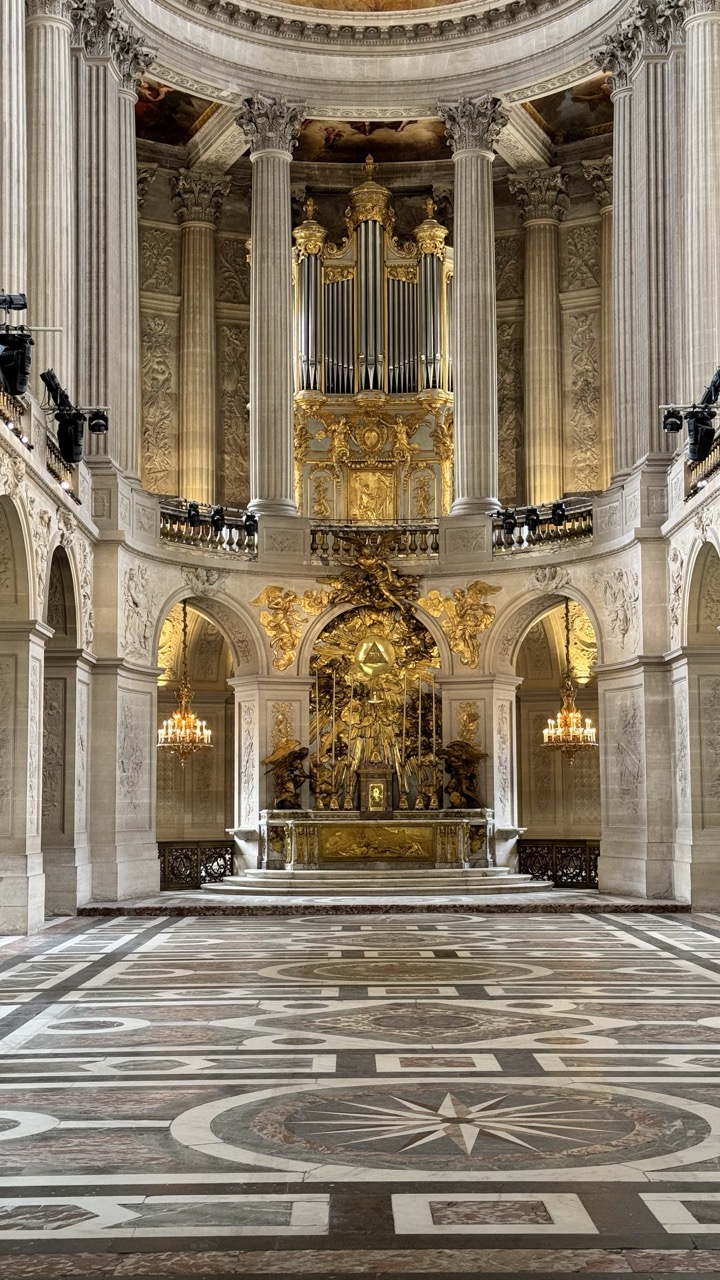

1. Overall Rating (0–10) — 8.5
This photograph captures the grandeur and spiritual solemnity of a Baroque cathedral interior with striking clarity and reverence. The symmetrical composition and rich textures—from the polished marble floor to the gilded organ and altar—create a sense of awe and timelessness. While the scene is visually overwhelming, the image succeeds in conveying both architectural majesty and sacred stillness, though a slight adjustment in lighting balance could enhance depth.
2. Composition (0–10) — 9.0
The image is masterfully framed with strong symmetry, drawing the eye directly to the central altar and organ. The wide perspective emphasizes the scale of the space, while the repeating arches and columns create a rhythmic visual flow that guides the viewer toward the focal point.
3. Lighting (0–10) — 7.5
The lighting is warm and evenly distributed, highlighting the golden accents and architectural details. However, the ambient light feels slightly flat in the upper sections, where shadows are less defined, reducing the sense of three-dimensional depth in the ceiling and upper columns.
4. Color & Tone (0–10) — 8.0
The palette is rich and harmonious, dominated by gold, cream, and deep maroon tones that evoke opulence and reverence. The contrast between the luminous gold and the cool stone enhances the visual drama, while the earthy floor adds grounding balance.
5. Creativity (0–10) — 8.5
The photographer captures a moment of stillness in a dynamic space, transforming a religious interior into a contemplative visual narrative. The choice to include subtle modern elements—such as the stage lighting rigs—adds a quiet layer of juxtaposition between tradition and contemporary use, enhancing the image’s conceptual depth.
6. Technical Quality (0–10) — 9.0
The image is sharp and detailed, with excellent clarity across the frame. The focus is precise, and the dynamic range is well-managed, preserving texture in both the marble and the gilded ornamentation.
7. Emotional Impact (0–10) — 9.0
The photograph evokes a profound sense of reverence and quiet grandeur, inviting contemplation. The stillness of the space, combined with the rich details and symmetry, creates a deeply immersive experience that resonates with spiritual and historical weight.
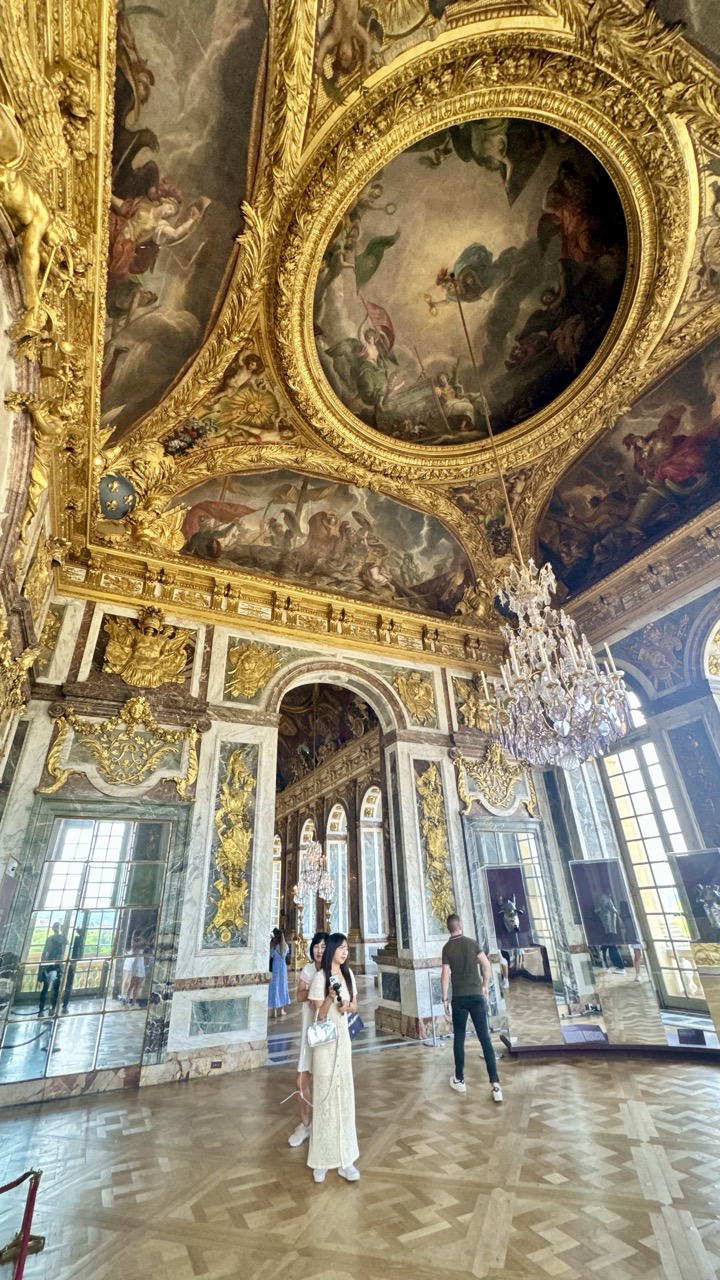

1. Overall Rating (0–10) — 7.5
This photograph captures the opulent grandeur of a Baroque palace hall, where human scale meets architectural splendor in a compelling contrast. The lavish gilded details, ceiling frescoes, and crystal chandelier create a sense of historical majesty, while the presence of visitors grounds the scene in the present. Though the composition is rich in texture and narrative, the casual stance of the figures slightly undermines the formality of the setting, creating a tension between timelessness and immediacy.
2. Composition (0–10) — 7.0
The low-angle perspective emphasizes the soaring ceiling and intricate ornamentation, drawing the eye upward. The placement of visitors near the center provides scale and anchors the composition, though the inclusion of reflections and multiple windows slightly fragments the visual focus.
3. Lighting (0–10) — 8.0
Natural light streams in through the tall windows, illuminating the space with a soft, diffused glow that enhances the golden tones of the gilded moldings. The interplay of light and shadow across the marble and ceiling paintings adds depth and dimension, while the chandelier remains a subtle focal point without overpowering the scene.
4. Color & Tone (0–10) — 8.0
The palette is dominated by rich golds, deep maroons, and creamy whites, creating a harmonious and regal atmosphere. The warm tones of the wooden floor complement the gilded elements, while the subtle contrast between light and shadow enhances the visual richness without introducing harshness.
5. Creativity (0–10) — 7.0
The image successfully juxtaposes the monumental past with contemporary life, offering a narrative of tourism and cultural heritage. The photographer’s choice to include people in the frame adds a human dimension, transforming the scene from a mere architectural record into a story of experience and wonder.
6. Technical Quality (0–10) — 8.5
Sharp focus across the frame captures fine details in the ceiling frescoes and ornate carvings. The exposure is well-balanced, preserving highlights in the windows and shadows in the recessed areas. The wide-angle lens is used effectively to encompass the scale of the room without significant distortion.
7. Emotional Impact (0–10) — 8.0
The image evokes a sense of awe and reverence for human artistry and historical achievement. The presence of visitors invites the viewer to imagine themselves in the space, fostering a connection to both the grandeur of the past and the continuity of cultural appreciation.
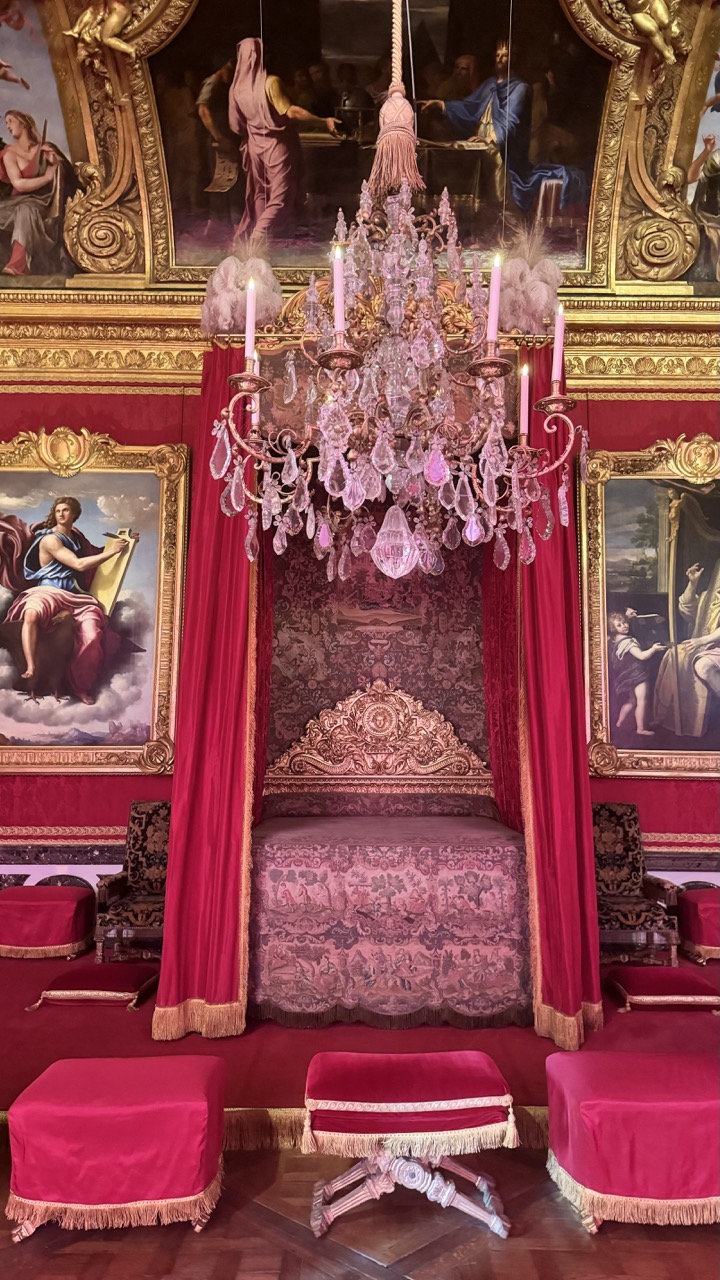

1. Overall Rating (0–10) — 8.0
This photograph captures the opulent grandeur of a royal chamber, where every detail—from the gilded frames to the cascading chandelier—speaks of absolutist power and artistic excess. The composition centers on a regal bed flanked by heavy velvet drapes and richly painted canvases, evoking both intimacy and monumentality. While the scene is visually overwhelming, its clarity and richness elevate it beyond mere documentation into the realm of historical storytelling, though the sheer density of ornamentation risks overwhelming the viewer’s eye.
2. Composition (0–10) — 8.0
The symmetrical arrangement centers the bed and chandelier, creating a powerful focal point that draws the eye upward. The balance of vertical and horizontal lines—drapes, paintings, and architectural elements—guides the viewer through the space with a sense of order and ritual.
3. Lighting (0–10) — 7.5
The ambient light, likely a mix of natural and artificial sources, highlights the gilded surfaces and crystal chandelier, enhancing their reflective qualities. While the lighting is even and reveals detail, it lacks dramatic contrast, softening the scene’s theatricality.
4. Color & Tone (0–10) — 9.0
The dominant crimson red and gold create a rich, luxurious palette that reinforces the room’s regal character. The subtle variations in tone—from deep burgundy to pale pink in the chandelier—add depth and elegance, while the warm undertones unify the composition.
5. Creativity (0–10) — 8.5
The image captures not just a space, but a narrative of power, ceremony, and artistic patronage. The deliberate framing and attention to detail reflect a creative vision that honors the historical context while making it accessible to the modern viewer.
6. Technical Quality (0–10) — 8.5
Sharp focus and clear detail are evident throughout, particularly in the intricate carvings of the bed and the delicate crystals of the chandelier. The camera’s resolution captures the textures and craftsmanship without distortion.
7. Emotional Impact (0–10) — 8.0
The image evokes awe and reverence, inviting the viewer to imagine the life of a monarch within this sacred space. The combination of luxury, ritual, and history creates a powerful emotional resonance, though the formality of the scene maintains a slight emotional distance.
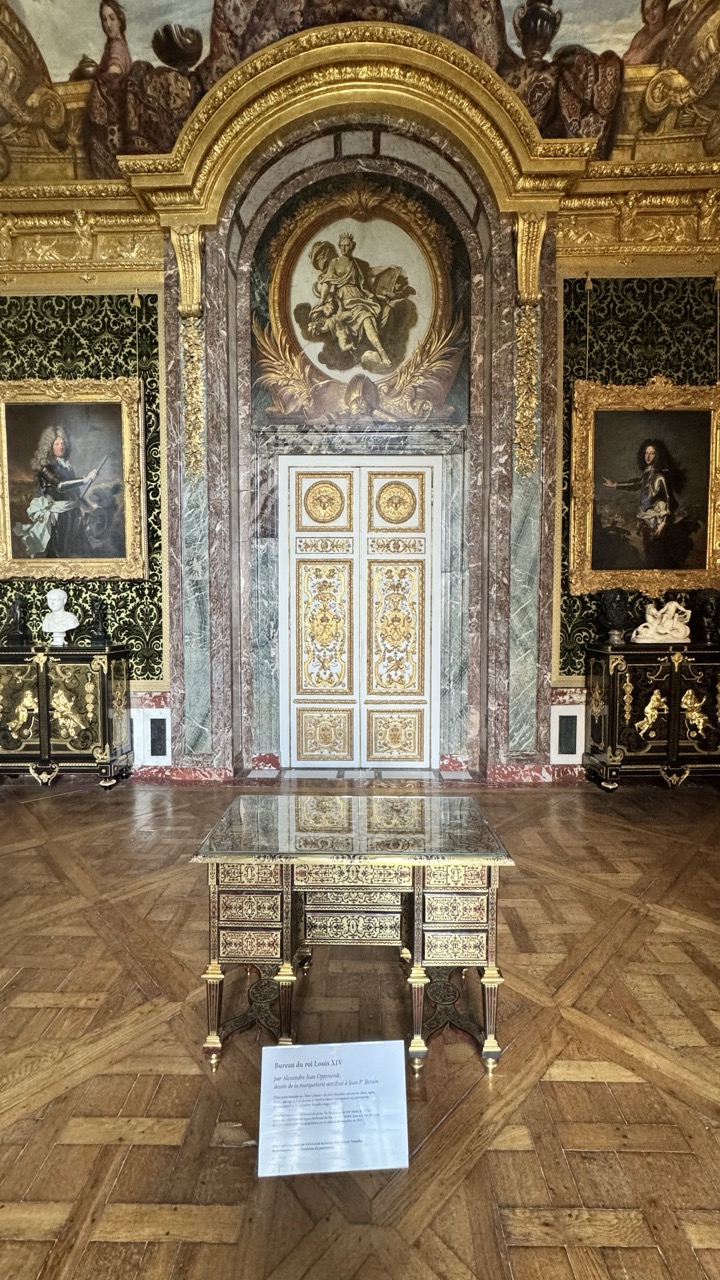

1. Overall Rating (0–10) — 8.0
This photograph captures the opulent grandeur of a royal chamber, where every detail speaks of absolute power and artistic refinement. The symmetry and lavish decoration evoke the splendor of Versailles, with the gilded desk and ornate door serving as focal points of imperial authority. While the image is rich in historical texture and design, the flat, even lighting slightly diminishes the dramatic depth that such a space demands.
2. Composition (0–10) — 9.0
The image is masterfully composed with strong central symmetry, drawing the eye directly to the ornate door and the framed relief above it. The placement of the desk in the foreground grounds the scene, while the flanking portraits and cabinets create visual balance and depth.
3. Lighting (0–10) — 6.5
The lighting is even and functional, illuminating the space clearly but lacking directional warmth or shadow play. This flat illumination softens the richness of the gold leaf and marble, reducing the sense of three-dimensional luxury.
4. Color & Tone (0–10) — 8.0
The palette is rich and harmonious, dominated by deep greens, golds, and warm wood tones. The contrast between the dark wallpaper and bright gilding enhances visual interest, while the neutral floor provides a grounding counterpoint.
5. Creativity (0–10) — 7.5
The photograph succeeds in capturing a moment of historical stillness, presenting the room as both a relic and a stage. The inclusion of the informational placard adds narrative context, subtly inviting the viewer to imagine the life that once filled this space.
6. Technical Quality (0–10) — 8.5
The image is sharp and well-focused, with excellent detail visible in the intricate carvings and inlays. The clarity of the text on the placard and the textures of the wood and marble are rendered with precision.
7. Emotional Impact (0–10) — 7.0
There is a quiet reverence in the image, evoking awe for the wealth and artistry of the past. The stillness of the scene invites contemplation of power, legacy, and the passage of time, though the lack of human presence keeps the emotional connection somewhat detached.
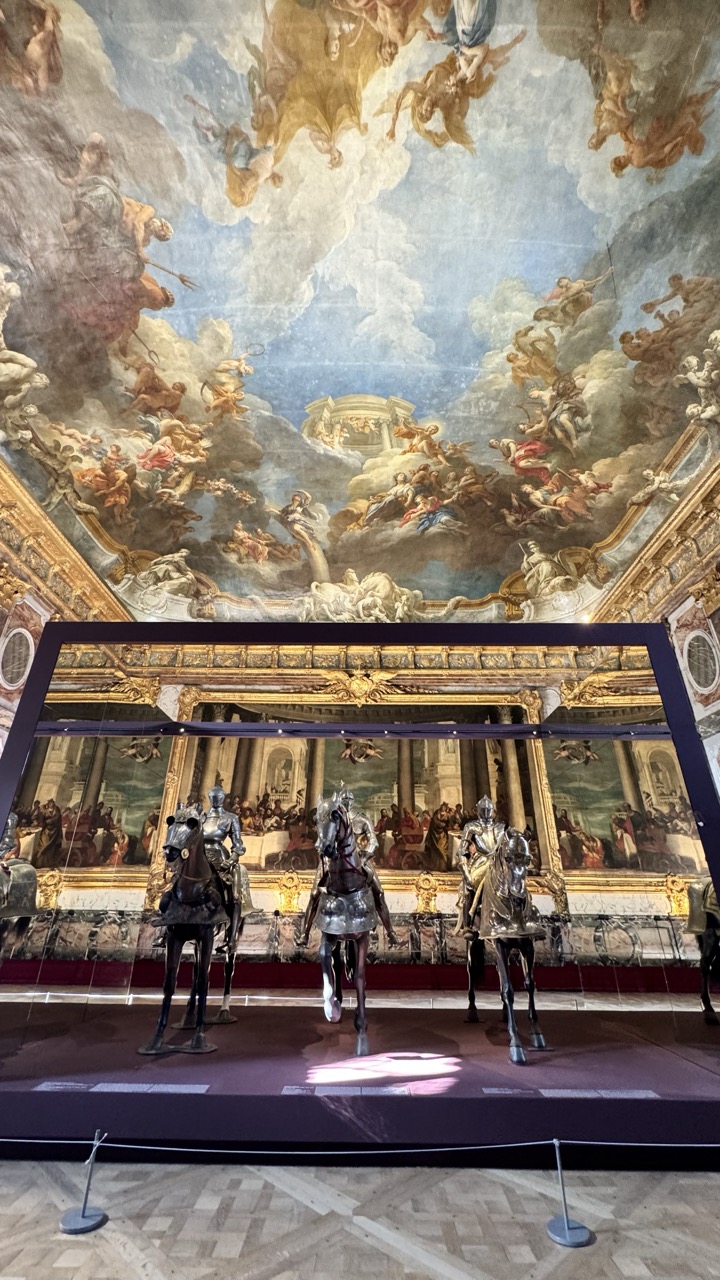

1. Overall Rating (0–10) — 8.0
This photograph captures the grandeur of a historic gallery, where opulent Baroque artistry meets the solemn presence of medieval armor. The ceiling fresco, with its swirling angels and dramatic light, dominates the frame, creating a powerful contrast with the grounded, metallic figures below. While the composition is rich in detail and atmosphere, the modern display case and lighting equipment subtly disrupt the historical immersion, hinting at the tension between preservation and presentation.
2. Composition (0–10) — 8.0
The low-angle framing emphasizes the ceiling’s vastness and the scale of the fresco, while the armor stands are centered to draw the eye forward. The use of symmetry in the display and the ornate backdrop creates a balanced, harmonious structure, though the foreground barrier slightly disrupts the visual flow.
3. Lighting (0–10) — 7.0
The lighting is a mix of ambient museum illumination and a focused spotlight on the armor, which enhances texture and metallic sheen. The natural light from the fresco’s painted sky blends with the artificial glow, creating a layered effect. However, the spotlights cast harsh shadows and a pinkish reflection on the floor, slightly detracting from the scene’s authenticity.
4. Color & Tone (0–10) — 8.0
The palette is rich and varied—golden gilding, deep maroon, and soft blues in the fresco create a warm, regal tone. The metallic grays of the armor provide a cool contrast, enhancing the visual depth. The overall tonal balance is strong, with a harmonious interplay between the warm and cool elements.
5. Creativity (0–10) — 8.0
The juxtaposition of Baroque grandeur and medieval armor is inherently compelling, and the photographer captures this historical dialogue with sensitivity. The framing intentionally highlights the contrast between the divine imagery above and the earthly power below, suggesting a narrative of legacy and conquest.
6. Technical Quality (0–10) — 8.0
The image is sharp and detailed, with clear focus on both the fresco and the armor. The depth of field is well-managed, allowing the viewer to appreciate the intricate details of the ceiling and the display. The slight reflections and reflections from the glass case are minimal and do not significantly compromise clarity.
7. Emotional Impact (0–10) — 8.0
The photograph evokes awe and reverence, drawing the viewer into a space where history, art, and power converge. The grandeur of the ceiling and the stoic armor together create a sense of timelessness and solemn beauty, inviting contemplation on the passage of power and artistic expression.
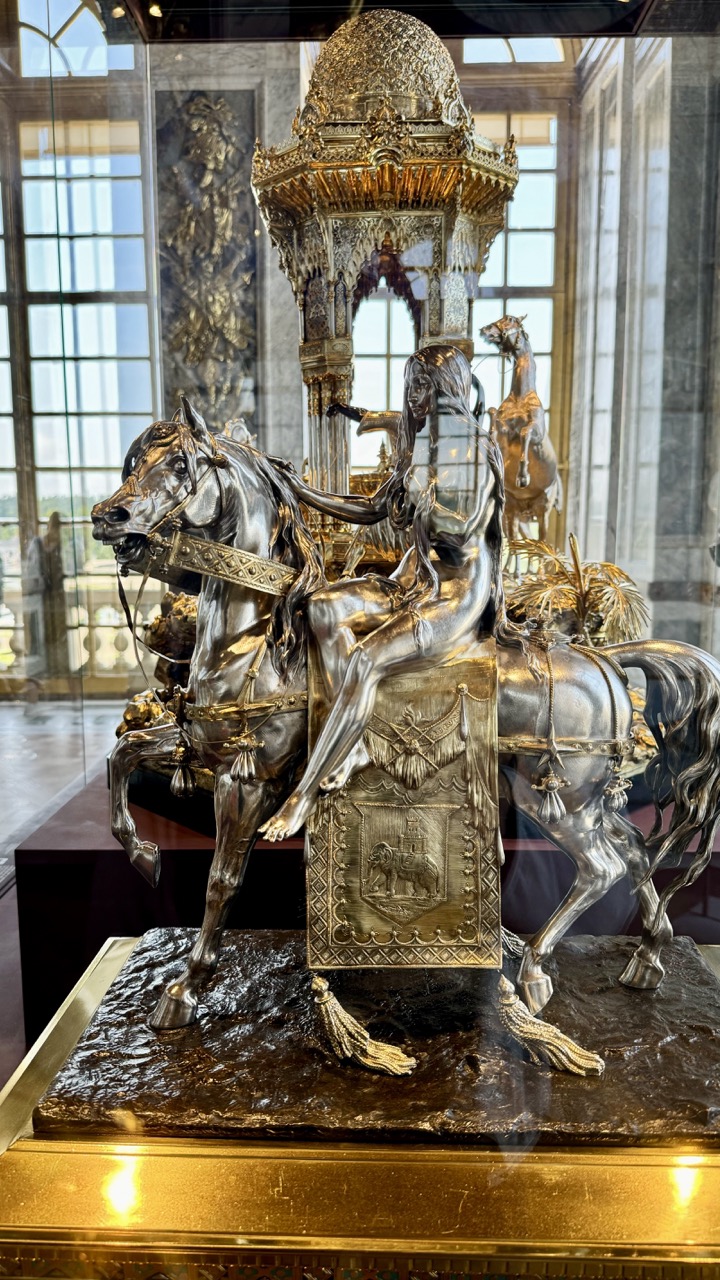

1. Overall Rating (0–10) — 8.0
This photograph captures the opulent grandeur of a baroque silver sculpture, where intricate craftsmanship and historical narrative converge in a moment of still reverence. The interplay of light on the polished metal surfaces enhances the sculpture’s three-dimensional complexity, while the reflective glass case adds a layer of modern context. Though the background hints at a museum setting, the image remains focused on the artistry and scale of the piece, though a slightly more intentional framing could further emphasize its narrative weight.
2. Composition (0–10) — 7.5
The sculpture is well-centered, with the rider and horse forming a strong diagonal that guides the eye upward toward the ornate canopy. The glass reflection and background architecture provide context without overwhelming the subject, though the depth of field could be tighter to isolate the sculpture more clearly.
3. Lighting (0–10) — 8.0
Natural light from the windows behind illuminates the sculpture from the back and side, creating dynamic highlights on the metallic surfaces and enhancing the sense of volume. The warm glow of the display lighting below adds a subtle contrast and emphasizes the base, contributing to the image’s dramatic tone.
4. Color & Tone (0–10) — 8.0
The palette is dominated by rich silvers and golds, with deep shadows that add contrast and depth. The warm golden tones of the base and lighting complement the cool metallics, creating a harmonious and regal aesthetic that underscores the sculpture’s historical significance.
5. Creativity (0–10) — 7.5
The photograph successfully captures the artistry and scale of a rare object, presenting it as both a historical artifact and a work of visual splendor. The inclusion of reflections and architectural elements adds narrative depth, suggesting the sculpture’s place within a larger cultural context.
6. Technical Quality (0–10) — 8.5
The image is sharp and detailed, with excellent clarity in the intricate carvings and textures of the metal. The focus is precise, and the exposure balances the highlights and shadows effectively, preserving detail across the sculpture.
7. Emotional Impact (0–10) — 7.5
The image evokes a sense of awe and reverence, inviting the viewer to contemplate the craftsmanship and historical weight of the piece. The combination of light, form, and reflective surfaces creates a quiet dignity that resonates with the viewer’s sense of wonder.
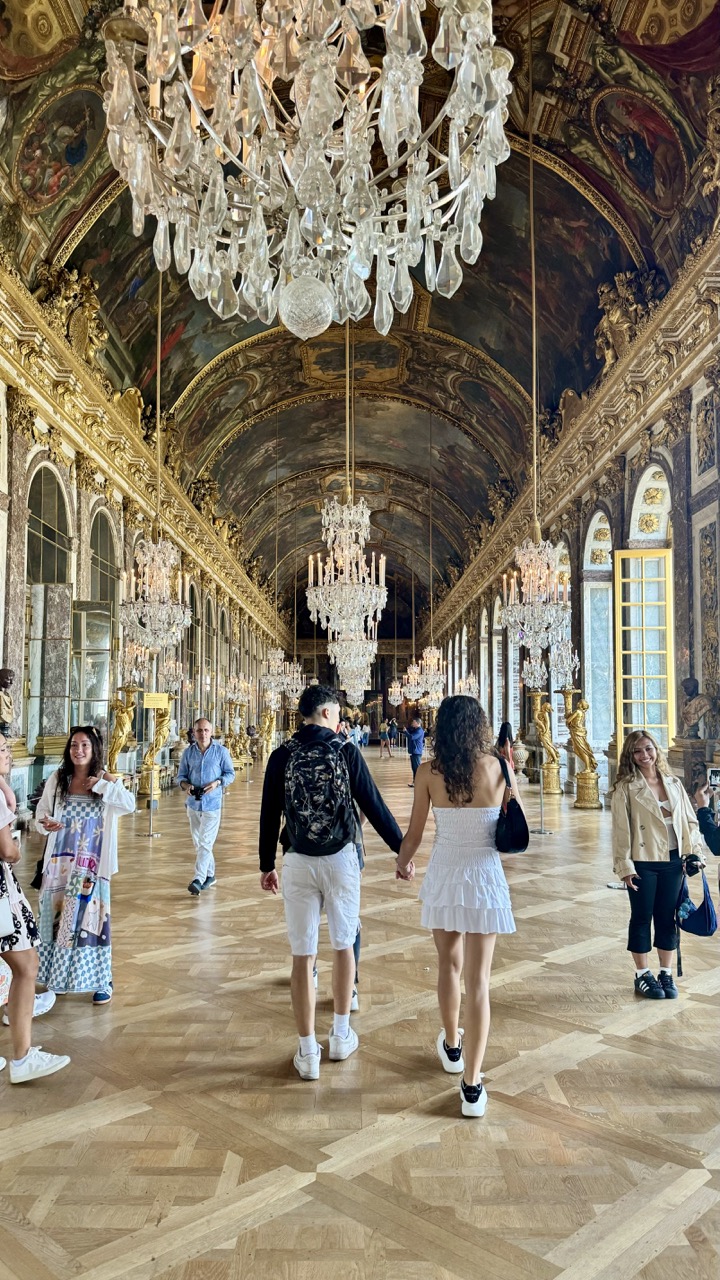

1. Overall Rating (0–10) — 7.5
This photograph captures the grandeur of the Hall of Mirrors at Versailles with a compelling blend of opulence and human scale. The interplay between the ornate architecture and the casually dressed visitors creates a dynamic contrast, emphasizing both the historical weight and the living presence of the space. While the image is visually rich and layered with detail, the composition's depth and the sheer volume of elements slightly dilute the focus, preventing it from achieving a more refined aesthetic harmony.
2. Composition (0–10) — 7.0
The strong leading lines of the hall, guided by the symmetry of the mirrors and chandeliers, draw the eye deep into the frame. The couple in the foreground provides a human anchor, grounding the scene and offering a sense of scale. However, the presence of multiple figures on the left and right edges introduces visual clutter, slightly disrupting the intended balance.
3. Lighting (0–10) — 7.5
Natural light from the windows at the far end illuminates the space with a warm, golden glow, complementing the reflective surfaces of the mirrors and the polished wood floor. The chandeliers add depth and sparkle, their crystal details catching the light and enhancing the sense of luxury. The lighting is rich and atmospheric, creating a sense of depth and grandeur without harsh shadows.
4. Color & Tone (0–10) — 8.0
The palette is dominated by warm golds, rich browns, and soft whites, evoking a sense of regal elegance. The contrast between the gilded embellishments and the cool tones of the ceiling frescoes adds visual interest. The overall tone is warm and inviting, with a balanced saturation that highlights the textures and craftsmanship of the space.
5. Creativity (0–10) — 7.5
The photograph successfully captures a moment of everyday life within a historically significant setting, merging the grand and the ordinary. The framing, which includes both the architectural splendor and the visitors, tells a story of cultural engagement. While the concept is familiar, the execution feels fresh and immersive, offering a personal perspective on a well-documented landmark.
6. Technical Quality (0–10) — 8.5
The image is sharp and well-focused, with clear details visible in both the foreground and background. The depth of field is appropriate, keeping the main subjects and key architectural elements in focus while allowing the background to recede slightly. The exposure is well-managed, preserving highlights in the chandeliers and shadows in the ceiling without loss of detail.
7. Emotional Impact (0–10) — 7.0
The image evokes a sense of awe and wonder, capturing the visitor’s experience of being immersed in a space of historical and artistic significance. The presence of the couple holding hands adds a subtle narrative of romance and connection, enhancing the emotional resonance. The viewer is invited to imagine themselves walking through the hall, feeling the weight of history and the beauty of the surroundings.
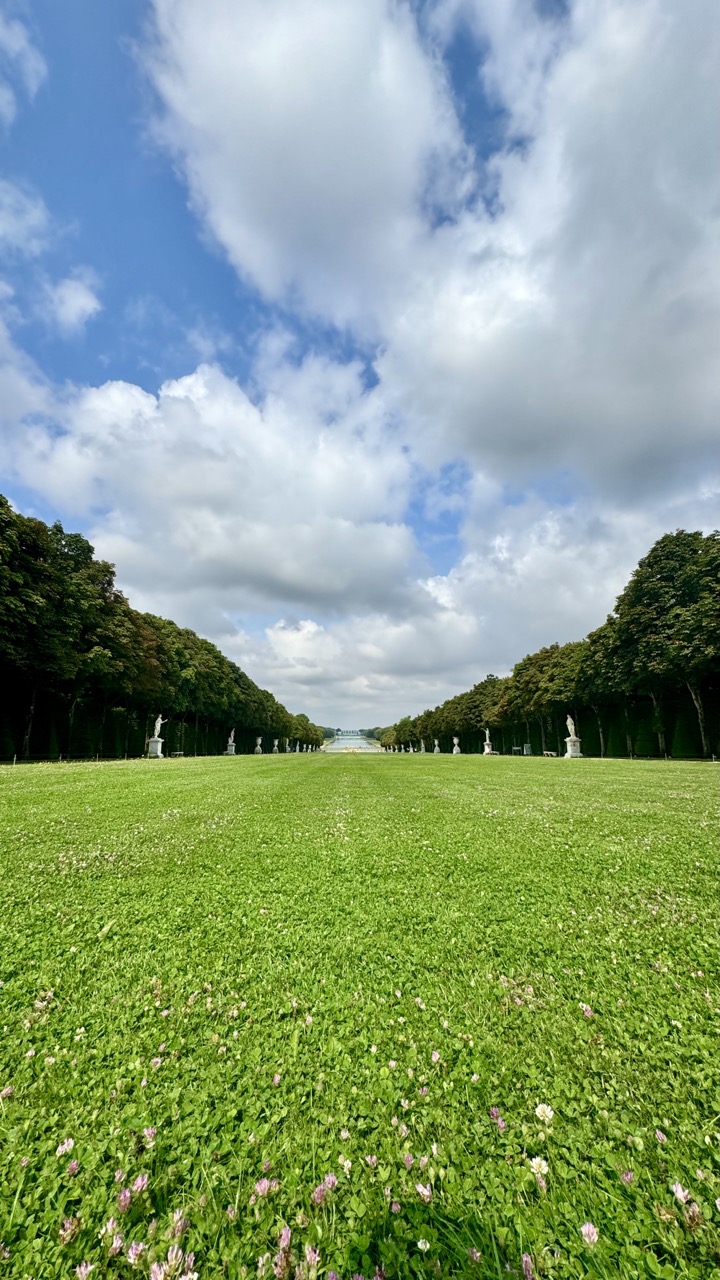

1. Overall Rating (0–10) — 8.0
This photograph captures the grandeur and symmetry of a formal garden, evoking a sense of timelessness and order. The sweeping expanse of green leads the eye toward a distant focal point, while the dramatic sky adds a touch of romanticism. The composition balances natural beauty with human design, though the scattered wildflowers in the foreground slightly disrupt the strict formality, lending a subtle, organic charm.
2. Composition (0–10) — 9.0
The strong leading lines of the tree-lined avenues create a powerful sense of depth and perspective, drawing the viewer’s gaze toward the vanishing point. The symmetry is nearly perfect, with the statues adding rhythmic punctuation. The low-angle framing emphasizes the vastness of the lawn and sky, enhancing the scene’s majestic scale.
3. Lighting (0–10) — 8.0
Natural daylight illuminates the scene evenly, with soft, diffused light filtering through the clouds, minimizing harsh shadows. The interplay of bright highlights and soft shadows adds dimension to the trees and lawn, while the sky’s dynamic cloud formations contribute to a luminous, airy atmosphere.
4. Color & Tone (0–10) — 8.5
The vibrant emerald green of the lawn contrasts beautifully with the deep blue of the sky and the soft white of the clouds. The inclusion of delicate pink and white wildflowers in the foreground introduces a gentle, naturalistic touch to the otherwise structured palette. The overall tone is fresh and balanced, with a natural vibrancy that feels both serene and alive.
5. Creativity (0–10) — 7.5
The image successfully merges classical garden design with a contemporary, slightly unpolished aesthetic through the inclusion of wildflowers. This subtle contrast between cultivated order and natural spontaneity lends the photograph a fresh, thoughtful perspective on a well-known landscape.
6. Technical Quality (0–10) — 9.0
The image is sharp and clear, with excellent detail in the grass, trees, and distant statues. The focus is consistent from foreground to background, and the exposure is well-balanced, preserving detail in both the bright sky and the shaded areas beneath the trees.
7. Emotional Impact (0–10) — 8.5
The photograph evokes a sense of peace, wonder, and awe, inviting the viewer to imagine strolling through this vast, sun-dappled space. The combination of symmetry, scale, and natural beauty creates a deeply calming and contemplative mood, resonating with both the grandeur of human artistry and the quiet persistence of nature.
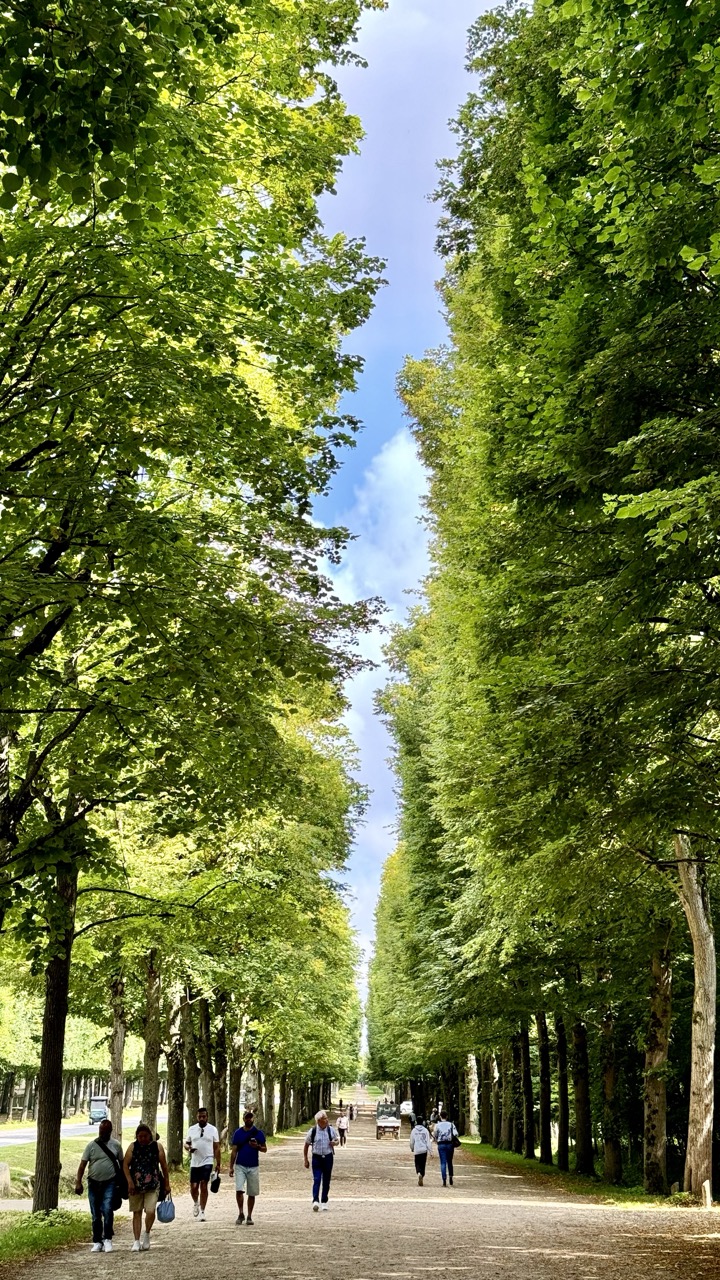

1. Overall Rating (0–10) — 8.0
This photograph captures the serene grandeur of a tree-lined avenue, where nature and human scale harmonize in a timeless procession. The towering canopy creates a natural cathedral, guiding the eye toward the vanishing point with quiet elegance, while the scattered figures lend a sense of life and movement. The image succeeds in conveying both awe and tranquility, though the slightly overexposed sky and cluttered foreground edges keep it from achieving full visual refinement.
2. Composition (0–10) — 8.5
The strong leading lines of the tree rows draw the viewer’s gaze into the distance, creating a powerful sense of depth and perspective. The placement of people along the path adds scale and narrative, while the framing from a low angle enhances the monumentality of the trees.
3. Lighting (0–10) — 7.5
Natural daylight illuminates the scene with a soft, even quality, highlighting the lush green foliage. However, the sky is slightly overexposed, losing some cloud detail and creating a stark contrast with the darker tree canopy.
4. Color & Tone (0–10) — 8.0
The vibrant greens of the leaves are rich and saturated, complemented by the clear blue of the sky. The overall tonal balance is pleasing, though the high contrast between light and shadow slightly flattens the midtones.
5. Creativity (0–10) — 7.5
The image leverages a classic compositional structure—symmetry, leading lines, and natural framing—to create a visually compelling narrative. While not radically original, it evokes a poetic sense of journey and passage through time and space.
6. Technical Quality (0–10) — 8.0
The focus is sharp along the central path, and the image is free of visible noise or distortion. The clarity of the foliage and the detail in the people’s clothing suggest a high-resolution capture, though the exposure in the sky could be more balanced.
7. Emotional Impact (0–10) — 8.5
The photograph evokes a deep sense of peace and contemplation, reminiscent of a walk through a grand European park or estate. The combination of natural beauty and human presence creates a meditative mood, inviting the viewer to imagine themselves strolling down the path.
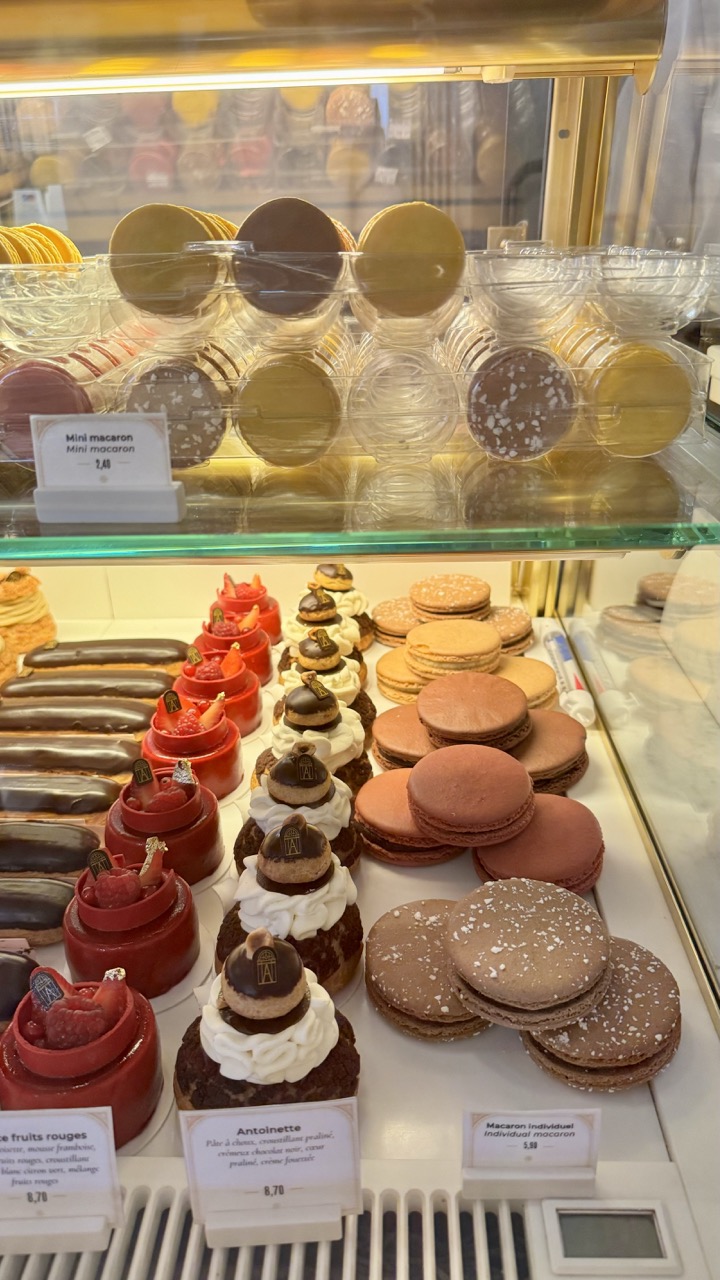

1. Overall Rating (0–10) — 7.0
This photograph captures the inviting abundance of a Parisian pastry case, where layers of macarons and petits fours beckon with color and texture. The warm lighting enhances the richness of the desserts, creating a sense of indulgence and artisanal care. While the image is visually appealing and well-organized, the lack of a clear focal point and slight overexposure in the top shelf slightly dilute its overall impact.
2. Composition (0–10) — 6.5
The frame is filled with overlapping elements, creating a sense of depth but also visual clutter. The diagonal arrangement of desserts leads the eye through the scene, though the top shelf slightly overwhelms the foreground, weakening the focus on key items.
3. Lighting (0–10) — 7.5
Warm, golden lighting enhances the richness of the pastries, creating an inviting glow that emphasizes texture and depth. The overhead case lighting is effective, though slightly harsh on the upper shelf, causing some loss of detail in the background.
4. Color & Tone (0–10) — 7.0
A rich palette of deep reds, browns, and creamy whites creates a visually harmonious and appetizing scene. The color temperature is warm and inviting, though the bright highlights in the background slightly flatten the tonal range.
5. Creativity (0–10) — 6.0
The image functions as a straightforward documentation of a bakery display, with little editorial or narrative intent. While the arrangement is pleasing, it lacks a unique perspective or conceptual twist.
6. Technical Quality (0–10) — 7.5
Sharp focus on the foreground desserts ensures clarity and detail, while the depth of field keeps the background slightly soft. The image is well-exposed overall, though minor overexposure in the upper section reduces detail.
7. Emotional Impact (0–10) — 7.0
The photograph evokes a sense of comfort and desire—of sweet treats waiting to be savored. The warmth and abundance create a feeling of indulgence, making it emotionally resonant for viewers who appreciate fine pastries.
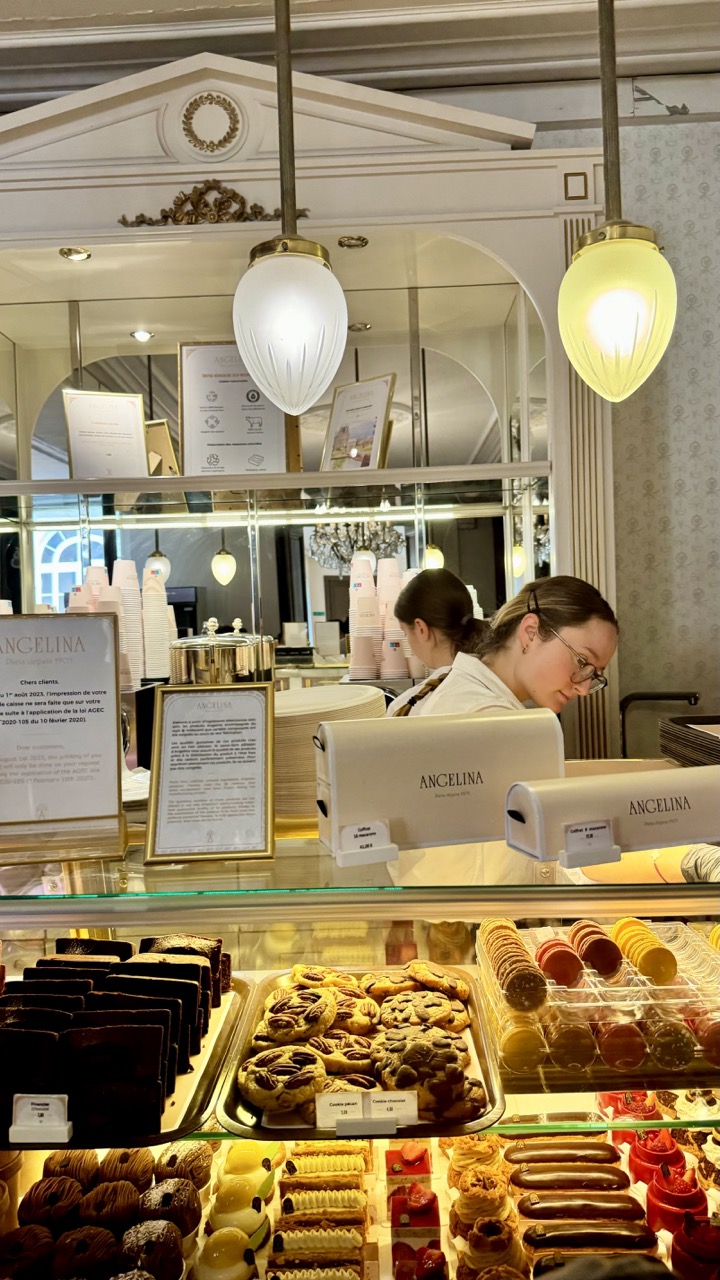

1. Overall Rating (0–10) — 7.0
This photograph captures the refined elegance of a French patisserie, where meticulous craftsmanship meets timeless design. The warm glow of the pendant lights enhances the inviting atmosphere, while the abundance of pastries invites indulgence. Though the composition is rich in detail, the clutter of signs and equipment slightly undermines the visual harmony, keeping the image from achieving a truly polished aesthetic.
2. Composition (0–10) — 6.5
The framing balances foreground and background effectively, with the pastry display drawing immediate attention. However, the inclusion of multiple signs and signage clutter in the lower-left creates visual distraction, slightly disrupting the flow and focus.
3. Lighting (0–10) — 8.0
Soft, warm lighting from the pendant fixtures enhances the cozy, luxurious mood, casting gentle highlights on the pastries and creating a welcoming ambiance. The glow complements the opulent architectural details above the counter.
4. Color & Tone (0–10) — 7.5
The palette is rich and inviting, with warm yellows and browns from the pastries and lighting balanced by the crisp white of the display and uniforms. The subtle contrast between the golden tones and the muted background enhances depth without overwhelming the scene.
5. Creativity (0–10) — 7.0
The image successfully blends documentary realism with artistic intent, capturing both the function and atmosphere of the space. The narrative of artisanal tradition is evident, though the approach remains conventional rather than boldly innovative.
6. Technical Quality (0–10) — 8.0
The image is sharp and well-focused, with clear detail in the pastries and signage. The exposure is well-balanced, preserving texture and depth without overexposure or harsh shadows.
7. Emotional Impact (0–10) — 7.5
The photograph evokes a sense of comfort, indulgence, and nostalgia, inviting the viewer into a world of sensory pleasure. The quiet focus of the staff and the array of tempting treats foster a feeling of warmth and quiet satisfaction.
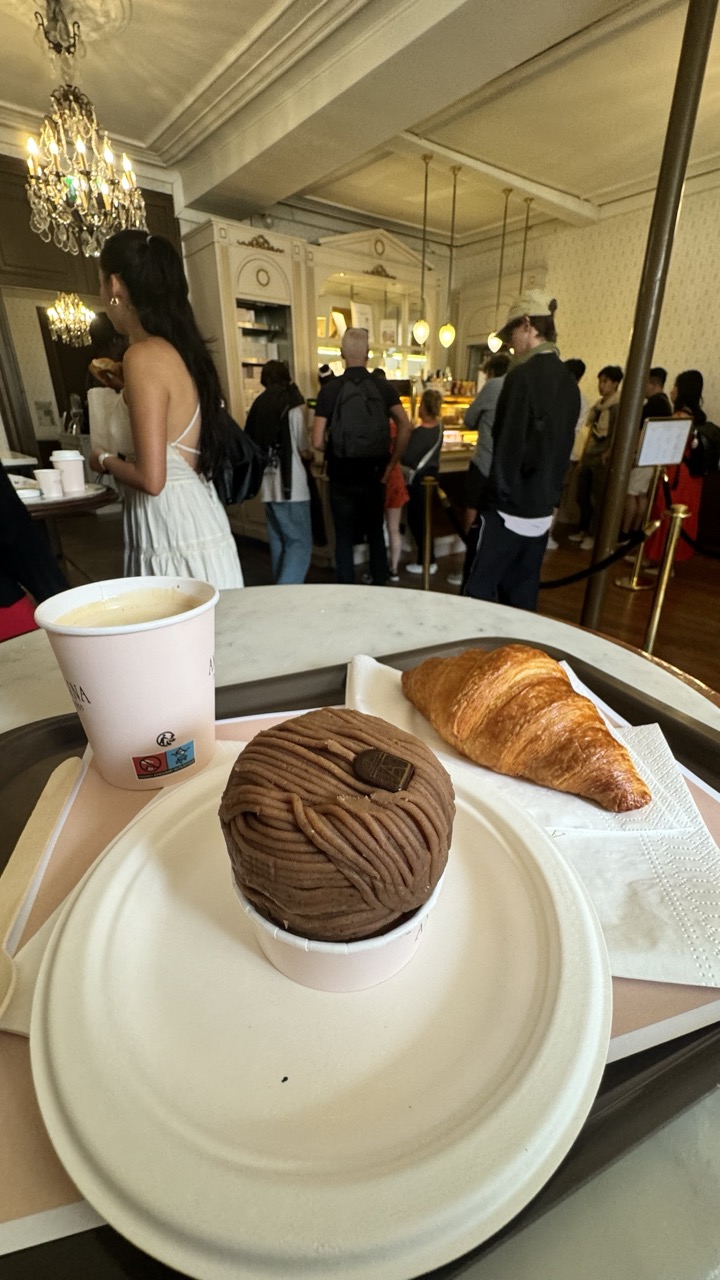

1. Overall Rating (0–10) — 6.8
This photograph captures the intimate warmth of a Parisian café, where the indulgence of a café au lait and a mont blanc takes center stage against the backdrop of elegant, bustling charm. The composition draws the eye to the foreground treats, grounding the image in sensory pleasure, while the softly lit interior and chandeliers add a layer of timeless sophistication. Though the scene feels slightly overexposed and the background cluttered, the image succeeds in conveying a moment of quiet luxury amid the city’s rhythm.
2. Composition (0–10) — 6.0
The foreground treats are well-placed, drawing immediate attention, but the background figures and architectural elements create a sense of visual noise. A tighter crop or more intentional depth of field could better isolate the subject.
3. Lighting (0–10) — 6.5
Warm ambient lighting enhances the inviting mood, with the chandeliers adding soft highlights. However, the overall brightness flattens some textures, and the flash-like illumination on the cup slightly disrupts the natural ambiance.
4. Color & Tone (0–10) — 6.5
The palette is cohesive, dominated by warm browns, creams, and soft golds, which complement the café’s traditional aesthetic. The slightly washed-out tones reduce vibrancy, but the overall harmony supports the scene’s inviting tone.
5. Creativity (0–10) — 7.0
The image captures a relatable yet elevated moment—French café culture through the lens of everyday indulgence. The inclusion of both the mont blanc and croissant adds narrative depth, suggesting a deliberate culinary experience.
6. Technical Quality (0–10) — 7.5
Sharp focus on the foreground treats contrasts with a softly blurred background, indicating a reasonable depth of field. The image is clear and free of major flaws, though minor noise is present in the shadows.
7. Emotional Impact (0–10) — 7.0
The photograph evokes a sense of comfort and quiet joy—familiar to anyone who has paused in a café to savor a sweet treat. The warmth of the setting and the indulgence of the food create a personal, almost nostalgic connection for the viewer.
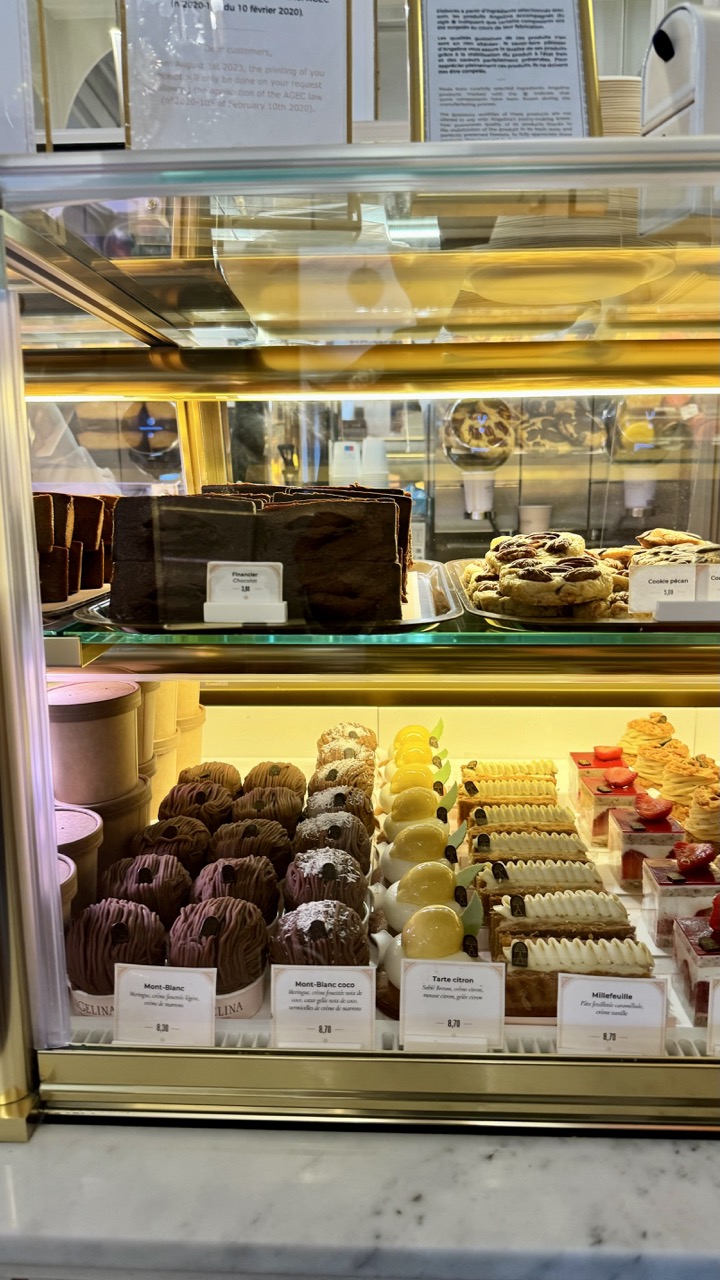

1. Overall Rating (0–10) — 7.0
This photograph captures the inviting allure of a Parisian patisserie, where the golden glow of display lighting enhances the decadent appeal of meticulously arranged pastries. The composition balances visual richness with a sense of order, drawing the eye across layers of confectionery, though the cluttered top shelf slightly disrupts the elegance. While the image celebrates the craft of pastry-making, its potential for deeper emotional resonance is tempered by a slightly overexposed, commercial aesthetic.
2. Composition (0–10) — 6.5
The frame is well-structured, with the pastries arranged in a clear diagonal flow from bottom left to top right. However, the upper shelf’s overlapping items and signage create visual busyness, pulling focus from the central display.
3. Lighting (0–10) — 7.5
Warm, directional lighting enhances the textures and gloss of the pastries, creating an inviting glow. The use of backlighting along the glass case adds depth and highlights the products effectively, though a slight overexposure in the top section reduces detail.
4. Color & Tone (0–10) — 7.0
The palette is rich and cohesive, dominated by warm yellows, browns, and creams that evoke indulgence. The contrast between the golden tones and the white marble base adds visual harmony, though the color saturation is slightly muted in the background.
5. Creativity (0–10) — 6.0
The image is conceptually straightforward—documenting a patisserie display—but it succeeds in conveying atmosphere and craftsmanship. The inclusion of price tags and French labels adds authenticity, grounding the scene in its cultural context.
6. Technical Quality (0–10) — 7.5
The focus is sharp on the foreground pastries, with clean detail in textures and labels. The reflections on the glass are present but do not significantly detract from clarity.
7. Emotional Impact (0–10) — 6.5
The photograph evokes a sense of temptation and delight, tapping into the universal appeal of sweet treats. While it captures the sensory pleasure of a bakery visit, the lack of human presence or narrative detail keeps the emotional connection at a surface level.
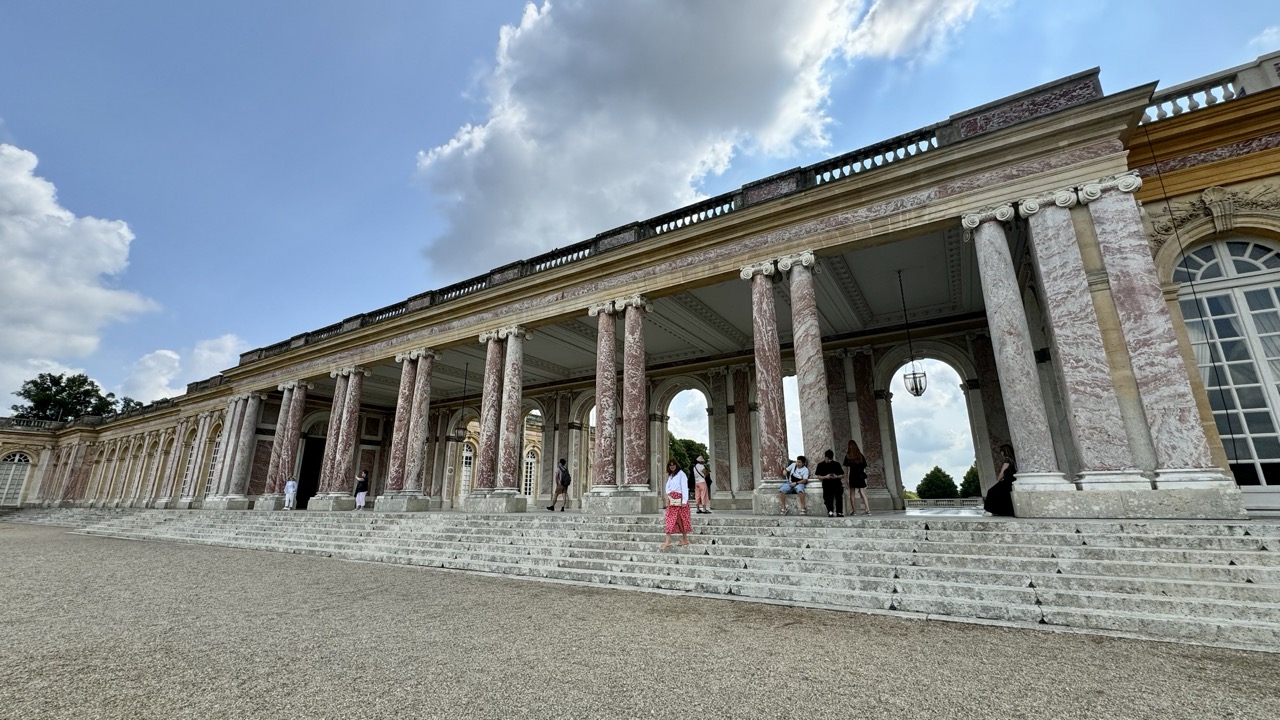

1. Overall Rating (0–10) — 7.5
This photograph captures the grandeur of a classical architectural space with a sense of stately elegance and quiet human presence. The interplay between the monumental colonnade and the expansive sky creates a striking balance between structure and openness. While the image successfully conveys the scale and historical weight of the setting, a slightly more dynamic angle or tighter framing could elevate its visual impact.
2. Composition (0–10) — 7.0
The low-angle perspective emphasizes the height and length of the colonnade, drawing the eye along the repeating arches. The placement of the steps and figures adds depth and scale, though the wide frame slightly dilutes focus on the central architectural details.
3. Lighting (0–10) — 8.0
Natural daylight enhances the texture of the marble columns and casts soft shadows that define the structure’s form. The bright sky contrasts with the shaded portico, creating a dynamic interplay of light and shadow that adds visual interest.
4. Color & Tone (0–10) — 7.5
The warm tones of the marble contrast beautifully with the cool blue of the sky, creating a harmonious palette. The subtle variations in the stone’s veining add richness, while the overall tonal range remains balanced and natural.
5. Creativity (0–10) — 7.0
The image presents a familiar architectural subject with a strong sense of place and atmosphere. While not overtly experimental, the composition and timing convey a thoughtful appreciation for the site’s historical and aesthetic significance.
6. Technical Quality (0–10) — 8.5
Sharp focus across the frame captures fine details in the stonework and architectural elements. The exposure is well-balanced, with no overexposed highlights or crushed shadows.
7. Emotional Impact (0–10) — 7.0
The image evokes a sense of awe and tranquility, inviting the viewer to imagine the history and stories that unfold within such a grand space. The presence of visitors grounds the scene in the present, creating a quiet connection between past and present.
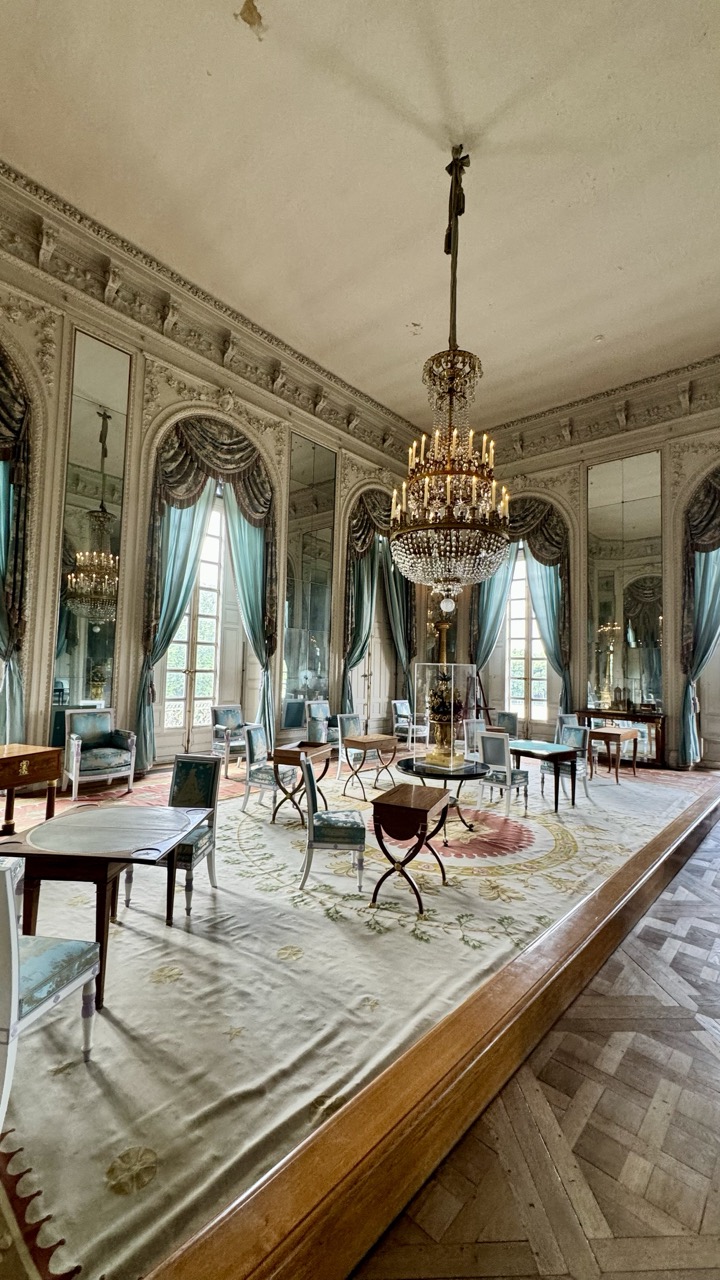

1. Overall Rating (0–10) — 7.5
This photograph captures the grandeur and decay of a once-opulent salon, where architectural elegance meets the quiet melancholy of time’s passage. The rich details of the ornate ceiling, mirrored walls, and crystal chandelier evoke a sense of historical splendor, while the slightly aged surfaces and uneven lighting lend a haunting, almost cinematic atmosphere. Though the composition is strong, the image’s emotional depth is tempered by a lack of dynamic contrast, keeping it from fully transcending its documentary roots.
2. Composition (0–10) — 7.0
The diagonal sweep of the raised platform and the repeating arches of the mirrors create a sense of depth and rhythm, drawing the eye toward the central chandelier. The placement of furniture is balanced, though the foreground edge slightly disrupts the visual flow, creating a subtle tension between the viewer’s vantage point and the space’s intended grandeur.
3. Lighting (0–10) — 6.0
Natural light filters softly through the windows, illuminating the room with a diffused glow that enhances the room’s vintage character. However, the flatness of the overhead light and the lack of dramatic shadows reduce the sense of dimension, making the scene feel more observational than atmospheric.
4. Color & Tone (0–10) — 7.0
The muted teal of the drapery, the cream of the walls, and the warm golds of the woodwork form a harmonious, historically resonant palette. The tonal range is subdued, with a slightly desaturated quality that enhances the feeling of age, though a touch more vibrancy could have made the chandelier and carpet stand out more.
5. Creativity (0–10) — 7.5
The photograph successfully juxtaposes opulence and decay, transforming the room into a narrative space. The use of reflections and symmetry adds layers of visual complexity, suggesting a story of lost magnificence—original and evocative in its quiet melancholy.
6. Technical Quality (0–10) — 7.5
The image is sharp and well-focused, with clean detail in the intricate moldings and carpet patterns. The exposure is balanced, though the slightly overexposed ceiling and underexposed foreground suggest minor limitations in dynamic range.
7. Emotional Impact (0–10) — 7.0
The room’s grandeur and signs of neglect create a poignant sense of nostalgia and loss, inviting contemplation on the passage of time. While not emotionally overwhelming, the image resonates with a quiet dignity that lingers after viewing.
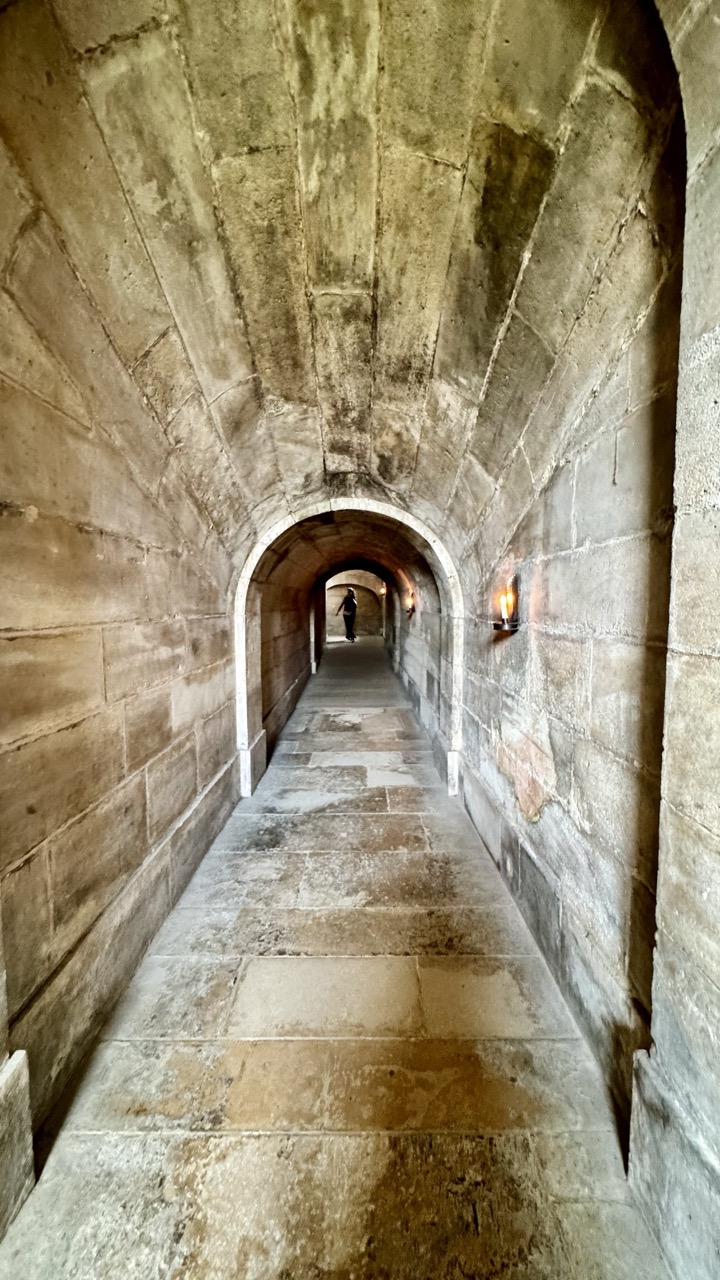

1. Overall Rating (0–10) — 7.0
This photograph captures the atmospheric weight of a medieval stone corridor, where history echoes in every weathered block. The deep perspective and subtle lighting create a sense of quiet mystery, drawing the eye toward the solitary figure at the far end. While the image effectively conveys a mood of ancient solitude, the slightly uneven exposure and muted tonality prevent it from feeling fully immersive.
2. Composition (0–10) — 8.0
The symmetrical framing and strong leading lines of the arched corridor create a powerful sense of depth and focus. The placement of the figure near the vanishing point enhances the narrative pull, guiding the viewer naturally through the space.
3. Lighting (0–10) — 6.5
The warm glow of the wall-mounted lamps adds a soft, ambient light that highlights texture and depth, though the overall illumination is uneven, leaving some areas in shadow. The natural light at the far end provides a subtle contrast, enhancing the tunnel’s dimensionality.
4. Color & Tone (0–10) — 6.0
The palette is dominated by earthy tones—browns, grays, and ochres—that reinforce the ancient, stone-laden atmosphere. However, the colors lack vibrancy and saturation, giving the image a somewhat flat appearance despite the rich textures.
5. Creativity (0–10) — 7.0
The image leverages architectural form and perspective to evoke a sense of time and journey. The inclusion of the lone figure introduces a human element, transforming the corridor from a mere structure into a narrative space, suggesting exploration or passage through time.
6. Technical Quality (0–10) — 7.5
The image is sharp and well-focused, with clear detail in the stonework and floor. The exposure is mostly balanced, though some shadow areas lose detail. The camera angle and focus are well-executed, enhancing the visual depth.
7. Emotional Impact (0–10) — 7.5
The photograph evokes a quiet contemplation of history and solitude, with a sense of quiet anticipation. The viewer is drawn into the corridor’s mystery, imagining the stories that might have unfolded within these walls—creating a strong emotional resonance with the past.
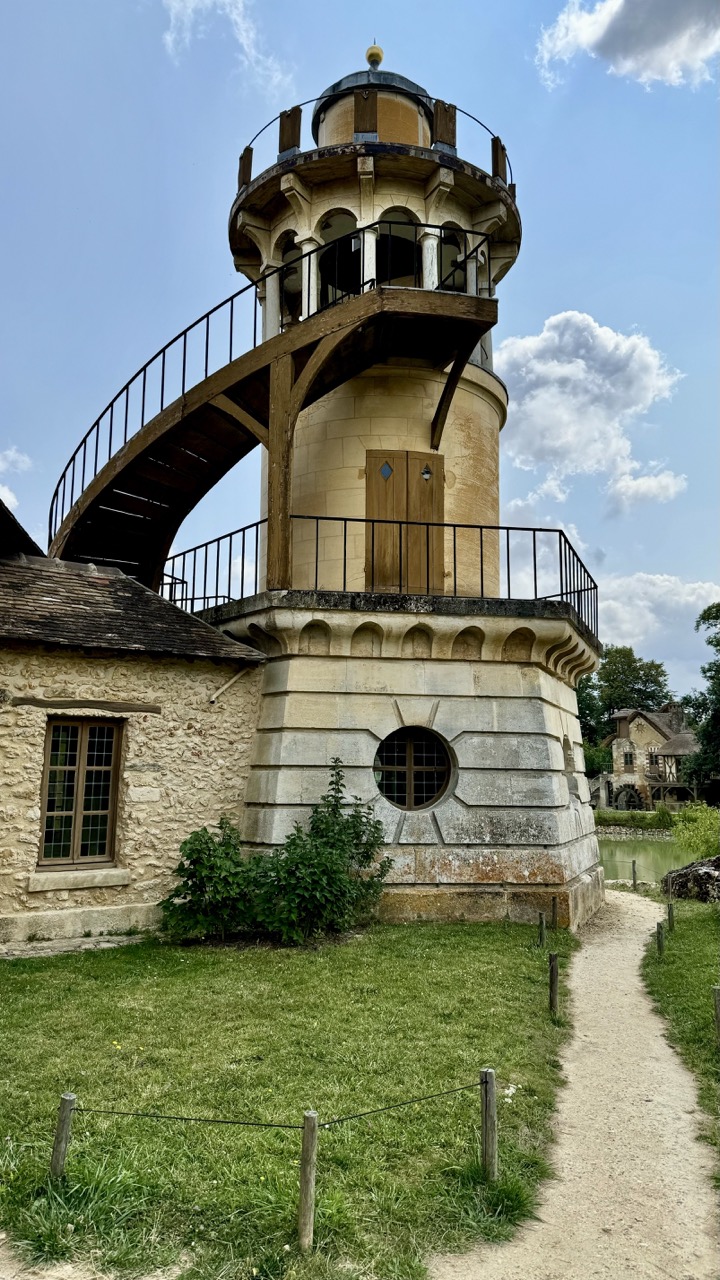

1. Overall Rating (0–10) — 7.5
This photograph captures the elegant charm of a historic folly tower, blending architectural detail with a serene natural setting. The interplay of light and shadow enhances the texture of the stone and wood, while the winding staircase adds a sense of movement and narrative. Though the composition is strong, a more dynamic angle or tighter framing could elevate its visual impact, making it feel less like a snapshot and more like a deliberate portrait of heritage.
2. Composition (0–10) — 7.0
The tower is well-framed, with the diagonal path leading the eye toward the structure, creating a natural visual flow. However, the inclusion of the adjacent building on the left slightly disrupts the balance, drawing attention away from the main subject.
3. Lighting (0–10) — 8.0
Bright, natural daylight enhances the textures and details of the tower, with soft shadows adding depth. The sky’s scattered clouds provide a dynamic backdrop without overpowering the scene.
4. Color & Tone (0–10) — 7.5
The warm beige of the stone contrasts beautifully with the green grass and blue sky, creating a harmonious palette. The slight coolness in the shadows adds depth without detracting from the overall warmth.
5. Creativity (0–10) — 7.0
The image successfully captures the whimsical and historical character of the structure, offering a glimpse into a preserved architectural curiosity. While not groundbreaking, it tells a quiet story of time and place.
6. Technical Quality (0–10) — 8.0
Sharp focus, clear detail, and well-balanced exposure contribute to a technically strong image. The depth of field is appropriate, keeping the tower in focus while softly blurring the background.
7. Emotional Impact (0–10) — 7.0
The photograph evokes a sense of peaceful nostalgia and quiet wonder, inviting the viewer to imagine the stories behind the tower’s design and use. It feels contemplative and grounded in history.


1. Overall Rating (0–10) — 7.5
This photograph captures the timeless elegance of a classical temple pavilion, set against a vibrant blue sky and lush greenery. The interplay of architectural symmetry and natural overgrowth creates a compelling contrast between human artifice and organic renewal. While the image succeeds in conveying the monument’s grandeur and historical resonance, its slightly low-angle framing and soft focus in the foreground limit its visual impact.
2. Composition (0–10) — 7.0
The temple is centered and framed by the natural foliage, creating a balanced and harmonious composition. The inclusion of the grassy foreground adds depth, though its soft focus slightly distracts from the main subject.
3. Lighting (0–10) — 8.0
Natural daylight illuminates the structure with soft, even light, highlighting the texture of the stone and enhancing the sense of space. The bright sky and subtle shadows contribute to a clear, airy atmosphere.
4. Color & Tone (0–10) — 7.5
The palette is rich and harmonious, with the warm beige of the marble contrasting beautifully against the deep green of the trees and the cool blue of the sky. The tonal range is well-balanced, giving the image a natural and inviting quality.
5. Creativity (0–10) — 7.0
The photograph captures a classic subject with a fresh perspective by emphasizing the juxtaposition of the man-made and the natural. The presence of visitors adds a human scale and narrative element, suggesting continuity and engagement with history.
6. Technical Quality (0–10) — 8.0
The image is sharp and clear, with fine detail visible in the architectural elements. The focus is well-placed on the temple, though the foreground grass slightly softens the overall sharpness.
7. Emotional Impact (0–10) — 7.0
The photograph evokes a sense of peace, reverence, and contemplation, inviting the viewer to reflect on time, beauty, and the enduring power of classical design. The presence of people grounds the scene in the present, creating a quiet emotional connection.
Loading map...